The A to Z of Baby Led Weaning - Complete Food Guide For Parents
This A–Z guide is your go-to resource for navigating baby led weaning foods—from everyday staples like cheese and zucchini to less common options. Whether you're wondering how to serve something safely or introduce new textures, you'll find clear, parent-friendly guidance, plus baby-safe recipe links and prep tips throughout.
Each entry covers what's safe, what to avoid, and how to serve food in a way that supports your baby's development and self-feeding skills.
Baby-Led Weaning: Overarching Principles
Baby-led weaning (BLW) is an approach to introducing solids that puts your baby in control. Rather than spoon-feeding purées, your baby explores whole foods using their hands and mouth — building confidence, fine motor skills, and a healthy relationship with food from the start.
This guide covers the key principles behind BLW, based on expert recommendations and public health guidelines from New Zealand, Australia, the UK, and beyond.
What Is Baby-Led Weaning?
Baby-led weaning means:
- Your baby joins in with family meals
- They feed themselves (no spoon-feeding needed)
- They explore food through touch, taste, and chewing
- They decide how much to eat and when to stop
This method supports natural development and turns mealtimes into a shared, sensory experience.
When to Start BLW
Most babies are ready for solids at around 6 months of age, but not before 4 months. Your baby may be ready when they:
- Can sit upright with support
- Have good head and neck control
- Can grab food and bring it to their mouth
- Show interest in what others are eating
These developmental signs are more important than age alone. Learn more about when to start solids
Why Choose Baby-Led Weaning?
- Encourages self-regulation and reduces overfeeding
- Promotes chewing, coordination, and oral development
- Reduces mealtime battles and picky eating
- Builds confidence and independence
- Supports family mealtimes and role modelling
It’s not just about food — it’s about learning, play, and connection.
Nutrition Basics for BLW
- Breastmilk or formula remains your baby’s main food source until 12 months
- Start solids with iron-rich foods: soft-cooked meats, lentils, tofu, egg,
- Offer a variety of foods: vegetables, fruit, grains, dairy, legumes, and meats
- Offer water in an open cup with meals from 6 months
- Aim for 2–3 meals per day to start, and build from there
Choking vs. Gagging: What’s Normal?
Gagging is a normal reflex as babies learn to chew and swallow.
To reduce choking risk:
- Always seat baby upright
- Let baby feed themselves (don’t put food in their mouth)
- Avoid choking hazards like whole grapes, raw apple chunks, popcorn, or whole nuts
- Cut foods into finger-sized pieces or offer soft foods with a “handle” (e.g. broccoli floret)
- Supervise your baby at all times during meals
Introducing Allergens
You don’t need to delay allergenic foods. In fact, early introduction may help prevent allergies.
Tips:
- Introduce allergenic foods (egg, peanut, dairy, wheat, fish) from around 6 months
- Offer one allergen at a time and monitor for reactions
- If tolerated, continue to offer regularly
- Talk to your GP or health visitor if your baby has eczema or a family history of allergies
Read more: Introducing allergens safely
Practical BLW Tips
- Let your baby eat what you eat — just adapt for safety
- Focus on soft, graspable foods at first (e.g. steamed vegetables, toast fingers, strips of meat)
- Don’t worry if little is eaten at first — it’s about exploration
- Skip added salt, sugar, and processed snacks
- Expect mess — use a mat under the highchair to help!
- Keep mealtimes calm, enjoyable, and unhurried
Explore: First foods to try |
BLW Recommendations Around The World
It should be noted that Baby-led weaning is not currently the recommended weaning method in all countries. For example it is not recommended according to public health guidance in New Zealand, although they do reccommend progressing textures and progressing to self feeding .
However, it is widely practised and recognised in many other countries including Australia and the UK. This guide is designed to support families who choose to explore BLW, with safety and responsiveness at the core. Always consult with your healthcare provider if you’re unsure about introducing solids or if your baby has specific needs.
Remember...
BLW doesn’t have to be all-or-nothing. Some families use a combined approach, offering soft finger foods alongside spoon-fed meals. The key is respecting your baby’s cues and offering a wide variety of nourishing, safe foods.
For more support, explore our Baby-Led Weaning Recipes and Getting Started with BLW resources.
The Ultimate Alphabetical List of Baby Led Weaning Foods
A
Acai Berries
Almonds
Anchovies
Fresh Anchovies (refer to fish)
Canned Anchovies
Anchovies are a rich source of omega-3 fatty acids, calcium, and iron, but salt content is a concern—especially for canned or preserved versions. Salted anchovies (like those in tins or jars) should be avoided for babies under 1 due to their very high sodium levels.
Apples
Apples are a popular first fruit, but raw apple slices can be a serious choking hazard for babies and toddlers. The key is making sure they’re soft and safe to handle.
How to Serve Apple for BLW
- Steamed or baked apple wedges are the safest starting point. Slice the apple into thick wedges or rounds and cook until you can easily squish them between your fingers. Let them cool slightly before serving.
- Grated raw apple is another great option and works well stirred into porridge or folded into baby-friendly pancakes.
- You can also serve apple purée on a preloaded spoon for babies who enjoy self-feeding with a little help.
- As your baby’s chewing skills develop, you can gradually offer firmer textures. Raw apple slices are best avoided until around 18 to 24 months, when most toddlers can safely manage them.
BLW Recipes Using Apples
Apricot
Fresh Apricots (refer to fruit)
Dried Apricots (refer to dried fruit)
Artichokes
Artichokes can be a bit tricky texture-wise — they’re naturally fibrous and some parts are too tough for little mouths. But the soft, tender hearts can absolutely have a place on your baby’s plate.
How to Serve Artichoke for BLW:
- Stick to the artichoke hearts only. These are the soft, edible parts found in the centre after removing the tough outer leaves and spiny choke.
- Cook fresh artichoke hearts until soft — steamed or boiled is best. Serve them chopped or in soft wedges that your baby can easily pick up and explore.
- Canned or jarred artichoke hearts are a great time-saver. Just rinse well to remove excess salt before serving.
- You can mash artichoke hearts or fold them into soft-textured meals like baby-friendly pasta dishes, mini frittatas, or grain bowls.
Arugula
(refer salad greens)
Asparagus
Asparagus is a lovely early veggie for baby-led weaning — it's naturally shaped like a handle, making it a perfect self-feeding finger food.
How to Serve Asparagus for BLW:
- Steam or roast whole spears until they’re soft and tender. They should squish easily between your fingers.
- Offer the whole spear to your baby to hold and gnaw on — the texture makes it great for oral motor exploration.
- Thicker spears are easier for babies to grip than the skinny ones. And it’s perfectly fine if baby mostly sucks or chews on them at first without swallowing much.
- For younger babies or those just getting started, you can cut spears into shorter lengths or mash cooked asparagus into other soft foods like mashed potato, lentil puree, or scrambled egg.
- Canned asparagus can be used in a pinch — just check the sodium content and give it a rinse. It's usually soft and can be stirred into other baby-friendly meals like mash, risotto, or veggie frittatas.
Top Tip: Asparagus can cause a noticeable change in urine smell — totally harmless but good to know ahead of time!
Aubergene/eggplant
Aubergine (also known as eggplant) becomes soft and velvety when cooked, making it a great veggie for baby-led weaning — as long as it’s prepared in a baby-friendly way.
How to Serve Aubergine for BLW:
- Roast or grill thick slices or wedges until soft and tender — they should be easy to squish between your fingers.
- You can also serve cooked cubes or mash the flesh into other soft-textured dishes like lentil stew, couscous, or pasta sauce.
- Aubergine naturally soaks up a lot of oil, so keep an eye on how much you use. Try brushing or lightly drizzling oil before cooking rather than soaking or frying.
- Avoid fried eggplant — it can become overly greasy and hard for babies to manage.
- Some babies might pull a face at first due to its slightly bitter taste, but keep offering it. Bitterness is a flavour worth introducing early, and repeated exposure often leads to acceptance.
Avocado
Avocado is one of the best first foods for baby-led weaning — it’s soft, nutrient-rich, and naturally the perfect texture for little mouths.
How to Serve Avocado for BLW:
- Offer thick slices or wedges straight from the fruit. It’s naturally soft and squishable, making it ideal for babies just starting solids.
- If it’s too slippery to handle, try rolling the slices in finely crushed cereal, ground flax, or hemp seeds to give it some grip.
- Mash it onto toast fingers for an easy handheld option.
- Mix mashed avocado with other soft foods like banana, cooked quinoa, or plain yogurt for a nutrient-dense combo.
- Avocado is also great for preloaded spoons — mash it and let baby bring the spoon to their mouth independently.

BLW Recipes Using Avocados
B
Bacon
(refer processed meats and sausages)
Bacon is covered under processed meats and sausages – but in short it is best avoided for babies due to very high salt content.
Bananas
Bananas are one of the easiest and most popular first foods for baby-led weaning — they’re naturally sweet, soft, and packed with nutrients babies need.
How to Serve Banana for BLW:
- Split a peeled banana lengthwise into thirds using your fingers — this creates natural, grippable pieces that are less slippery than whole slices.
- You can also cut thick chunks and leave part of the peel on to create a little “handle” for baby to hold.
- Mashed banana works beautifully on toast fingers, stirred into porridge, or blended into baby-friendly pancakes or muffins.
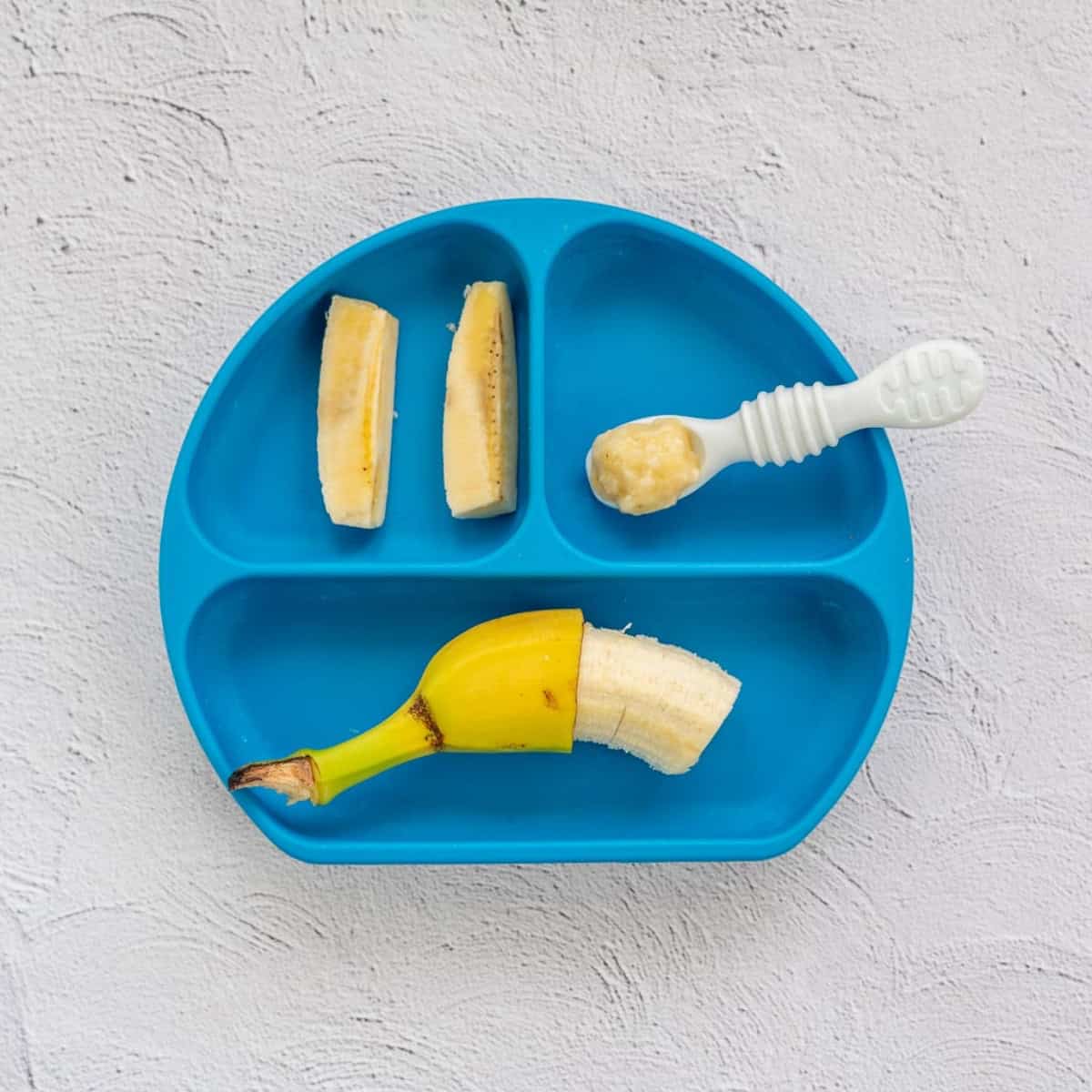
A few things to keep in mind:
Don’t be alarmed if you notice little black flecks in your baby’s nappy — the tiny seeds in banana can sometimes look a bit like coffee grounds. Totally normal!
Bananas are naturally binding, so they can slow your baby’s bowels if offered in large amounts early on. Go gently at first and mix with other fibre-rich foods if needed.
BLW Recipes Using Bananas
Beans, Peas, Lentils, Pulses
broad, black, black eyed peas, butter, cannellini, chickpeas, fava, garbanzo, pinto, kidney, lima
This group of plant-based foods is a fantastic source of iron, protein, and fibre — and often a big hit with babies once they’re cooked soft and served the right way.
How to Serve Pulses for BLW:
- Cook until very soft — all beans and lentils should be easily squishable between your fingers.
- Offer them whole if soft, or lightly mashed or flattened if the skins are a bit firm or they’re rolling away too easily.
- Use them in mashed spreads, veggie patties, lentil dahl, or soft-textured stews. They also blend well into fritters and baby-friendly burgers.
- Canned legumes are super convenient — just check for added salt and give them a good rinse before serving.
BLW Recipes Using Beans, Peas, Lentils, Pulses
Beef
Beets/Beetroot
Bell peppers/Capsicum
Bell peppers (also known as capsicum) are colourful, naturally sweet, and packed with vitamin C — perfect for adding variety and nutrition to your baby’s plate.
How to Serve Bell Peppers for BLW:
- For babies just starting solids, serve cooked bell peppers — think steamed, roasted, or sautéed until soft.
- Roasted pepper strips are easy for babies to grip and chew, and the vibrant colours make them visually appealing too.
- While bell peppers are often eaten raw by older children and adults, raw pepper can be too crunchy and pose a choking risk for babies under 12 months.
Tip: Red, yellow, and orange peppers are sweeter than green — they’re usually more popular with babies starting out.
Berries
Acai, Blackberries, Blueberries, Boysenberries, Strawberries,
How to Serve Berries for BLW:
- Soft, ripe berries like strawberries, raspberries, boysenberries, and blackberries can be served whole if they’re very soft and easy to squish.
- If berries feel firm or the seeds are large (e.g. blackberries), gently mash them before serving to reduce choking risk.
- Blueberries should be flattened with your fingers or cut in half lengthwise, especially before 12 months — whole blueberries are a known choking hazard for young babies.
- Acai is usually available in purée form (frozen packets or freeze-dried powder). It can be stirred into yogurt, oatmeal, or smoothies for a nutrition boost — just ensure the product is unsweetened and baby-safe.

Broccoli
Broccoli is a nutrient-dense veggie that’s ideal for baby-led weaning — it’s rich in fibre, vitamin C, and the floret tops make perfect natural handles for little hands.
How to Serve Broccoli for BLW:
- Steam or roast broccoli florets until very soft. The tops should squish easily between your fingers.
- The stalks can also be served, sliced into sticks — they’re often easier for babies to hold while exploring the florets.
- Some babies may gag at the fluffy texture in the early stages. That’s normal and tends to improve with repeated exposure.
- You can also mash broccoli into potato, pasta, or rice dishes to add nutrition and familiarity in a softer format.
- For a fun finger food twist, try Broccoli Tots — they’re easy to hold, soft to chew, and a great way to get in more veggies.
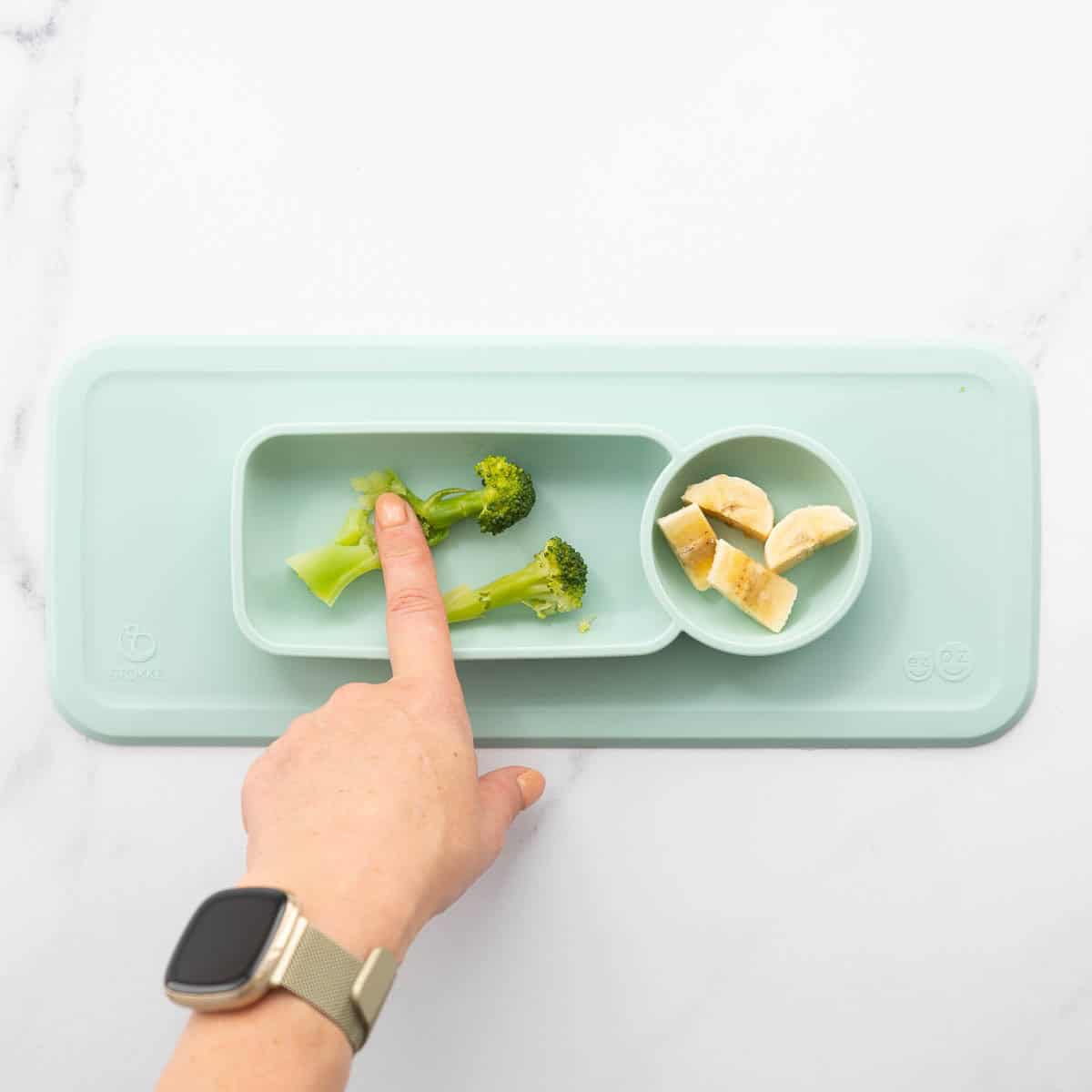
Broccolini
Broccolini is a hybrid of broccoli and Chinese kale. It’s more tender than broccoli and ideal for baby-led weaning when steamed or roasted until soft. Serve whole spears—babies can grip the stalks easily and munch on the soft tops.
Brussel sprouts
Brussels sprouts can be offered to babies from around 6 months once soft-cooked. Steam or roast until very tender. Serve halved or mashed for younger babies to reduce choking risk. Their slightly bitter taste may take some getting used to—pairing with sweeter veggies can help.
Bulgur wheat
Bulgur is a quick-cooking whole grain high in fibre and B vitamins. Once fully cooked and soft, it’s perfect for babies—serve fluffed as finger food, mixed into mashed veggies, or shaped into patties. Great for self-feeding or spoon practice.
Butter
Butter can be safely used in small amounts for babies. It adds energy and fat to meals—try a thin spread on toast or melt into cooked vegetables or grains. Choose unsalted butter to avoid excess sodium.
Butternut squash
Buttermilk
Buttermilk is safe to use in cooking and baking from 6 months, but shouldn’t be offered as a drink. You can use it in pancakes, muffins, or mashed potato for added creaminess. Choose varieties with no added salt or sugar. For more information refer to dairy.
C
Cabbage
Calamari/squid
Cantaloupe/Rock melon
Capers
Capers are typically preserved in brine or salt and are very high in sodium. They’re not recommended for babies under 12 months. Even rinsed, the salt content is too high for developing kidneys. Best to avoid until toddlerhood, and then only occasionally.
Capsicum/refer bell peppers
Carrots
Carrots are a nutritious choice for babies, offering beta-carotene (a precursor to vitamin A), fibre, and a mild natural sweetness. However, raw or undercooked carrots pose a significant choking risk, so proper preparation is essential.
From 6 months, carrots should always be cooked until very soft—they should easily mash between your fingers. Serve them:
- Cut into thick batons or spears (about the size of your pinky finger), steamed or roasted until soft. Babies can grasp these and gnaw safely.
- Try a crinkle cutter to create ridged edges that make the spears easier for little hands to hold.
- Mashed or finely grated into soft foods, like mashed potato, lentil dishes, or patties.
- Blended into soups or purees (if offering both finger foods and spoon-fed options).
As baby becomes more confident with chewing (around 9–10 months), you can start to experiment with grated raw carrot mixed into soft textures, but raw carrot sticks should still be avoided until well after the 12-month mark unless shredded finely.
Extra Tips
- Roasting brings out natural sweetness and enhances flavor.
- Add cooked carrot to family meals like stews, risottos, or mini muffins.
- Avoid small rounds (coins) of cooked carrot early on unless they're very soft and either mashed or cut in half.
- Carrots are a root vegetable, check the root vegetable secton for more tips
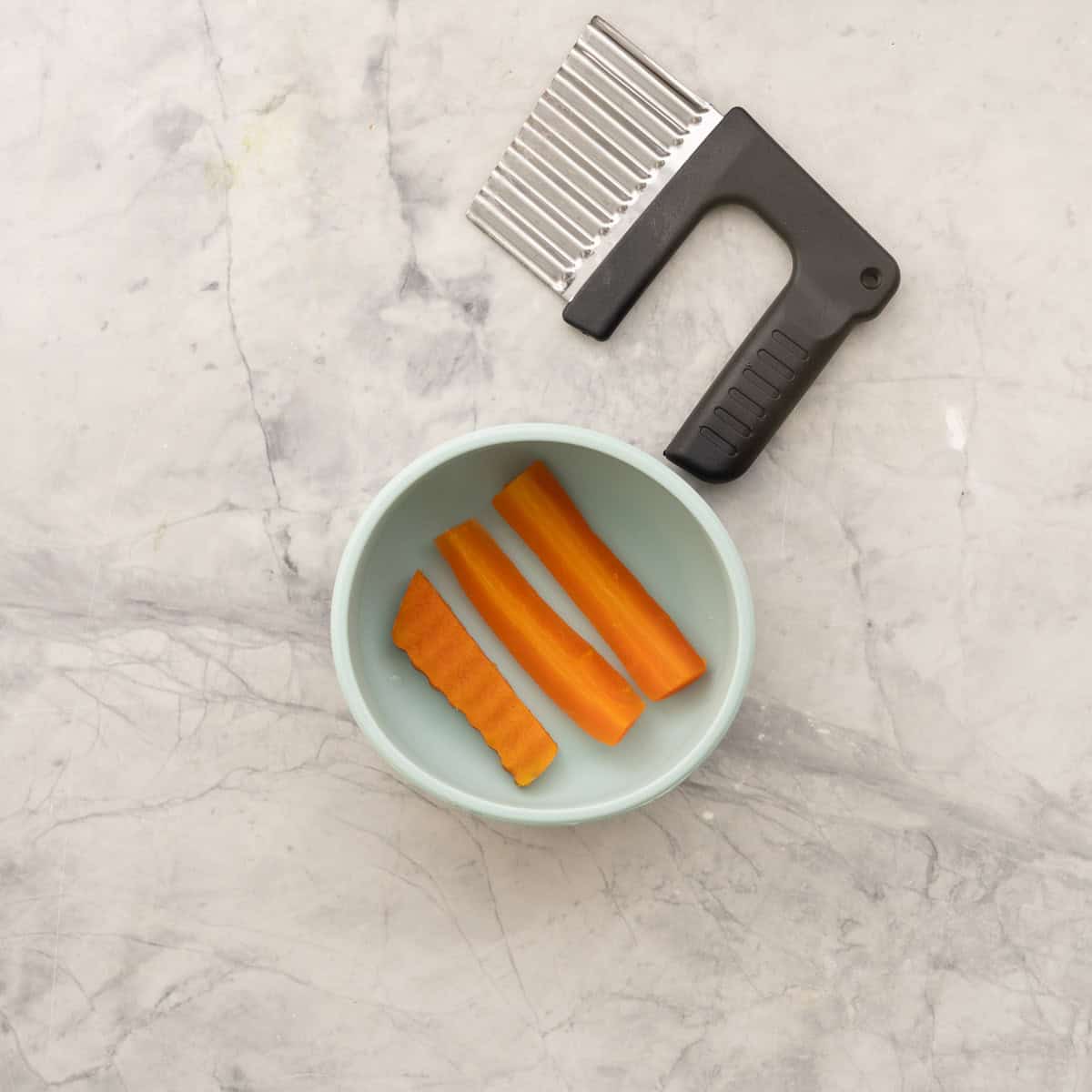
BLW Recipes Using Carrots
Cashews
(refer nuts & seeds)
Cauliflower
Cauliflower is a versatile, nutrient-rich vegetable that's ideal for baby-led weaning. It has a mild flavor that works well both on its own and mixed into meals.
From 6 months, serve cauliflower:
- Steamed or roasted cauliflower until soft, in large florets that baby can hold and explore.
- Mashed or blended into other dishes—great for boosting nutrition without overpowering flavor.
- In sauces, such as a creamy bechamel or cheese sauce (perfect for veggie-loaded mac and cheese).
- Combined with mashed potatoes to lighten the texture and add extra veg (cauliflower potato mash).
Caviar
Caviar is not recommended for babies due to its extremely high salt content and risk of contamination with harmful bacteria or heavy metals. It’s best avoided in infancy altogether.
Celeriac/celery root
Celery
Celery is fibrous and stringy, which can be tricky for babies to chew and swallow safely. It’s best served cooked until soft, either chopped or mixed into soups and stews. Raw celery sticks can pose a choking risk and are best avoided until at least 18 months or finely chopped.
Chard
Cheese
Cheese can be a nutritious and tasty option for babies, offering calcium, protein, and healthy fats. When serving cheese during baby-led weaning:
- Choose pasteurized, full-fat varieties such as cheddar, mozzarella, Colby, or cream cheese.
- Serve in thin strips, small cubes, or grated, depending on your baby’s developmental stage and pincer grasp.
- Soft cheeses (like ricotta, mascarpone, or cream cheese) can be spread on toast or mixed into mashed veggies, grains, or pasta.
- Hard cheeses can be served in matchstick-style strips for gnawing or melted into sauces or casseroles.
- Avoid cheeses that are mold-ripened (like brie or camembert), unpasteurized, or high in sodium.
For more on when and how to introduce dairy, and to understand the differences between milk, yogurt, cheese, and other dairy products in the first year, see the Dairy section of this guide.
Chia seeds
Chicken
(refer meat & poultry)
Chickpeas/garbonzo beans
(refer beans, peas, lentils pulses)
Chicory
(refer green leafy vegetables)
Chocolate
Chocolate contains sugar and caffeine (in the form of theobromine), and is not recommended for babies. Dark chocolate, in particular, has higher caffeine levels. Skip chocolate in the first year and choose naturally sweet foods like fruit instead. It’s okay in small amounts after 12 months, but ideally offered infrequently.
Chorizo
(refer processed meats and sausages)
Citrus Fruit
Citrus fruits like oranges, mandarins, lemons, limes, grapefruit, and tangelos are juicy and full of vitamin C. They can be a fun addition to your baby’s diet, but their natural acidity may occasionally cause mild skin irritation around the mouth or tummy discomfort in some babies—this isn’t harmful, just something to keep an eye on.
- Serve citrus in small, soft segments with the membranes removed, or cut through. This not only makes them easier to manage but also reduces the risk of choking, as the membranes can be tough and difficult for babies to break down.
- Cutting citrus fruit into wagon wheels (see the image below can be a cute and safe way to serve citrus as the membranes are all cut through.
- Skip citrus juice on its own—it’s too acidic, may contribute to tooth decay, and lacks the fiber of whole fruit.
- Try small amounts at first and see how your baby responds—some love it right away, others may need time.

Clementines
(refer citrus fruit)
Coconut (flesh)
Coconut is safe for babies and a good source of healthy fats. You can offer it in shredded, grated, or finely chopped form, mixed into foods like porridge, yogurt, or baked goods.
Avoid offering large chunks or tough pieces of raw coconut, as they can be difficult to chew and may pose a choking risk.
While coconut is technically a tree nut, it’s not considered a common allergen. Still, always monitor for signs of allergy—especially if your baby has other food allergies or there's a family history.
Coconut milk/cream
Coconut milk and cream can be safely used in cooking for babies, adding richness to curries, soups, porridges, and other family meals. Choose unsweetened, full-fat versions without added sugars or preservatives.
They’re fine in moderation as part of meals, but should not be used as a main drink or milk replacement. Coconut milk doesn't provide the nutrients babies need from breastmilk, infant formula, or fortified dairy alternatives.
Try coconut milk in baby-friendly recipes like:
Coffee
Coffee is not safe for babies or toddlers. It contains caffeine, which can negatively impact sleep, mood, and development. Keep all caffeinated drinks completely out of baby’s diet.
Corn
Corn is naturally sweet and baby-friendly. For younger babies, serve mashed or puréed corn, or offer whole kernels that have been lightly flattened between your fingers to reduce choking risk.
For older babies who can sit independently and chew well, corn on the cob is a fun and safe way to explore texture—just make sure it’s cooked until soft. You can try this quick and easy method: Microwave Corn on the Cob. Always supervise closely, as whole kernels can be a choking hazard if not prepared appropriately.
Corned beef
(refer processed meats and sausages)
Couscous
Couscous is a tiny, pasta-like grain made from semolina. It can be offered from around 6 months, once fully cooked and softened with water or low-sodium stock.
Because of its fine texture, couscous can be tricky for babies to pick up on its own. Try:
- Mixing it with mashed vegetables or soft sauces to help it clump together
- Offering it in spoonfuls or letting baby scoop it with their hands
- Forming it into patties or fritters for easier self-feeding
Avoid adding salt during cooking, and make sure the texture is soft and moist—not dry or crumbly—for younger babies.
Crab
(refer shellfish)
Crackers
Crackers can be introduced from around 9–10 months, depending on the type. The key is choosing options that are low in salt, easy to gum, and appropriate for your baby’s chewing ability.
Safer Options for Babies
- Some rice crackers, corn cakes, or teething wafers are good early options. These usually soften in the mouth and are easier to manage for babies still developing their chewing skills.
- Choose varieties that are unsalted and free from added sugar, ideally made from wholegrains or simple ingredients.
Use Caution With:
- Hard, crunchy crackers or crispbreads that may splinter into sharp pieces. These can be a choking risk, especially before molars have developed.
- Flaky, dry crackers that turn into dry clumps in the mouth—some babies may struggle to manage these safely.
Serving Tips
- Spread with soft, nutritious toppings like hummus, avocado, smooth nut butter, or soft cheese.
- Break into smaller pieces or allow baby to self-feed under close supervision.
Always monitor while eating, and choose crackers that match your baby’s developmental stage and chewing ability.
Cream cheese
Covered in more detail under the Dairy section, but in short: safe from 6 months if you choose full-fat, pasteurised varieties. Avoid flavoured or high-salt options.
Serve it spread thinly on toast, pancakes, soft veggie sticks, or as a base for snacks like pinwheels or rice cakes.
Cucumbers
Cucumbers can be offered from 6 months, but they need to be prepared with care due to their firm texture.
- Peel and remove the seeds.
- Serve in thick spears, with the inner flesh lightly steamed or scraped out to make them easier to manage.
- Raw cucumber can be soothing for teething babies thanks to its coolness, but may be too firm for early eaters to bite through safely.
Offer only in soft, manageable forms at first, and always supervise. As babies become more confident chewers, raw cucumber can become a great low-mess snack.
Looking for more ideas? Check out these Soothing Foods for Teething Babies
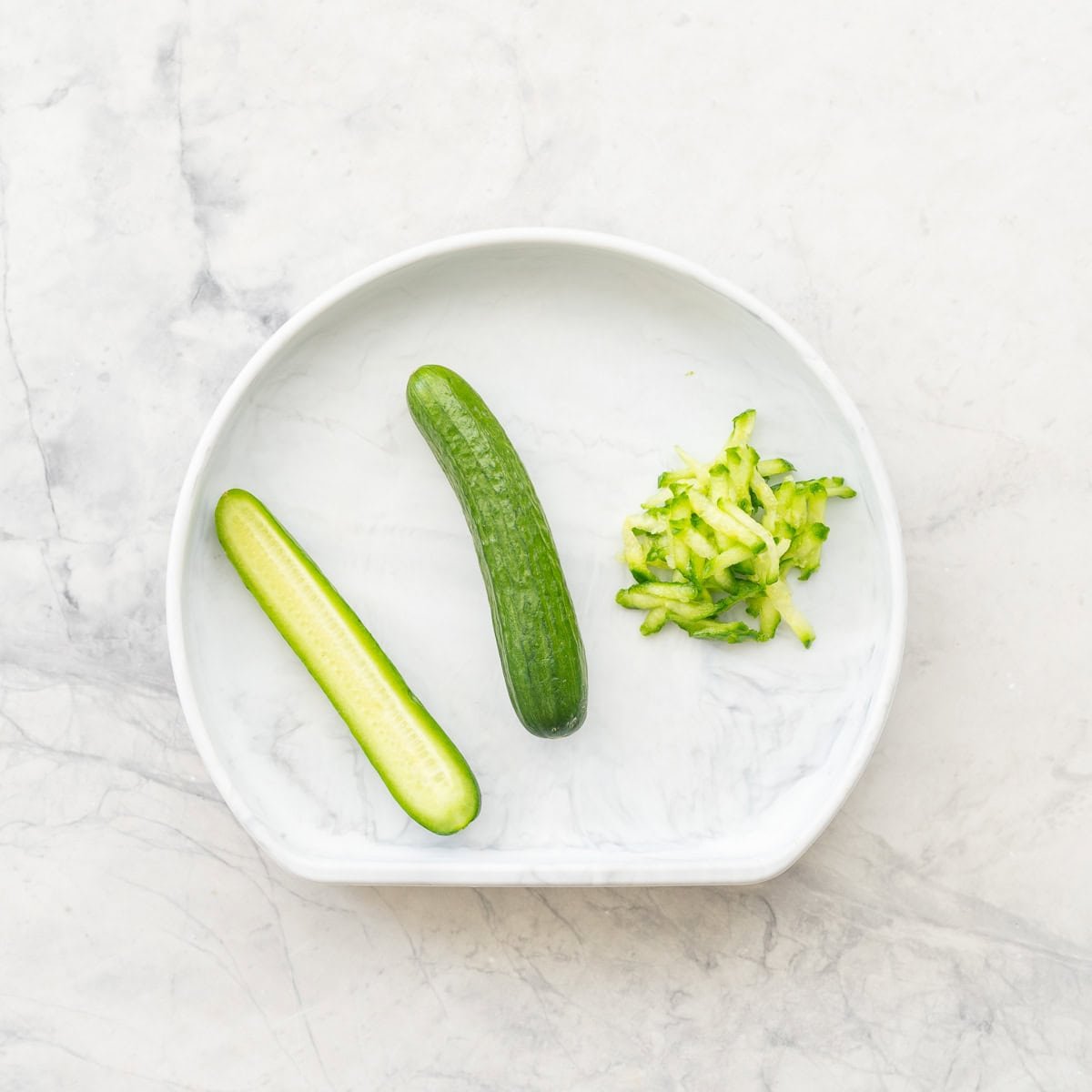
Custard
Homemade custard can be a lovely first food for babies from 6 months. When made with full-fat milk and egg yolks, it’s soft, creamy, and a natural source of iron—great for spoon practice too!
Just skip the added sugar for babies under 12 months. Store-bought or canned custards often contain added sugar, preservatives, or artificial flavours, so it’s best to stick with homemade.
Try this easy homemade baby custard recipe made just for little ones.
D
Dairy
While cow’s milk shouldn’t replace Dairy can be introduced from around 6 months of age in small amounts—as part of meals, not as a drink. This often causes confusion! While cow’s milk shouldn’t replace breast milk or infant formula as a drink before 12 months, it’s absolutely fine to use it in cooking, on cereal, or mixed into foods like mashed potato or porridge. You can read more about this here: When Can My Baby Have Cow’s Milk?
Dairy is one of the common allergenic foods, so it’s important to introduce it on its own—not at the same time as other new allergens—so you can watch for any reactions.
Baby-Friendly Dairy Options:
- Full-fat plain yogurt – avoid sweetened or flavoured varieties
- Cheese – hard cheeses like cheddar can be served grated, in sticks, or melted; soft cheeses like cream cheese or mascarpone can be spread on toast or stirred into meals
- Milk – full-fat cow’s milk can be used in cooking or baking (just not as a main drink)
- Butter – can be used in cooking or spread thinly
- Custard – homemade versions with no added sugar are a great option
- Avoid mold-ripened cheeses (like brie, camembert, and blue cheese) before 12 months due to the risk of listeria
Dairy foods are nutritious and can be great for adding protein, calcium, and healthy fats to your baby’s meals—just be mindful of added sugars and introduce them gradually, with care around allergens.

Dates
Dried Fruit
Dried fruit—like raisins, dates, apricots, prunes, and figs—might seem like a healthy snack, but for babies, it’s best to hold off. It’s sticky, chewy, and can be a real choking hazard when served whole. That’s why it’s not recommended as a first food for baby-led weaning.
Sticky foods like dried fruit can get stuck to the roof of the mouth or block the airway, and both the American Academy of Pediatrics and NICE guidelines recommend avoiding them in little ones under 4.
If you do want to use dried fruit later on, try soaking it in warm water until soft, then mash or finely chop it into meals or recipes like porridge or yogurt. Use it sparingly—it’s high in natural sugars and can be rough on baby teeth.
Safer sweet options for babies:
Soft fruits like ripe banana, stewed apple, or soft pear are much better for early eaters!
Duck
(refer meat & poultry)
E
Eggs
Eggs are a great early food for babies—they’re packed with protein, healthy fats, and key nutrients like choline and iron. They can be introduced from around 6 months of age.
Because eggs are a common allergen, it’s important to offer them early (ideally before 12 months) but safely—on their own and not at the same time as other new allergenic foods. That way, if there’s a reaction, it’s easier to pinpoint the cause.
Need more detail? Check out my full guide on Eggs for Baby, including how to introduce them and what signs of allergy to look out for.
Easy Baby-Friendly Egg Recipes:
- Mini Egg Muffins – great for breakfast or snacks
- Spinach Omelette Fingers – soft, holdable and veggie-boosted
- Egg Waffles – protein-packed and perfect for little hands
- Eggy Bread – a classic baby-led weaning favourite
Scrambled, boiled, mashed with avocado, or baked into muffins—eggs are super versatile and easy to adapt as your baby grows.
Eggplant/aubergine
Edamame
(refer beans, peas, lentils pulses)
F
Fennel
Fennel is safe for babies from around 6 months—as long as it’s cooked until soft. Raw fennel is too firm and can be a choking risk, but once cooked, it becomes tender and has a lovely mild, slightly sweet flavour.
There are no major allergy concerns with fennel, and it’s generally well-tolerated.
How to Serve Fennel:
- Roasted wedges – Roast thick slices until soft and golden
- Steamed or sautéed strips – Cook until mashable and cut into easy-to-grab pieces
- Mixed into meals – Add to soups, stews, or sauces
- Mashed – Blend with other veggies for a sweet, aromatic mash
Tip: Younger fennel bulbs are more tender. Skip the tough outer layers or stalks unless very well cooked and chopped small.
Feta
Frankfurter/Hot Dogs
(refer processed meats and sausages)
Not recommended for babies under 12 months.
Frankfurters and similar processed sausages raise multiple concerns when it comes to baby-led weaning.
Why They're a Problem:
- Choking risk: Hot dogs are one of the top choking hazards for young children. Their round shape, smooth surface, and firm texture make them especially dangerous—never serve in rounds.
- High in salt: Most are very salty—way beyond what’s safe for babies.
- Heavily processed: While they contain protein, they’re low in overall nutritional value and often include preservatives, additives, and saturated fat.
- Nitrates/nitrites: Common in processed meats, these additives are best avoided in infant diets.
See more about the health concerns here: Processed Meats and Babies
If You Serve Them Later:
For toddlers over 12–18 months, occasional small amounts may be okay if:
- You choose low-sodium, nitrate-free options
- They are fully cooked
- You slice them lengthwise into thin strips, never rounds
- They’re served alongside more nutritious foods

Figs
Fresh figs are a lovely option for baby-led weaning when they’re ripe and soft. Naturally sweet and high in fibre, they’re gentle on little mouths and unlikely to pose a choking risk when served appropriately.
How to Serve Fresh Figs:
- Choose soft, ripe figs that give slightly to pressure
- Cut into quarters or strips for easy gripping
- Remove the tough stem tip before serving
Note: Dried figs are a different story—they’re sticky, chewy, and not safe for babies under 12 months. For more on this, see the Dried Fruit section.
Fish
Fish is a fantastic first food—full of protein, omega-3s, and nutrients that support your baby’s brain and development. It’s generally safe from 6 months, as long as it’s well-cooked, boneless, and introduced one at a time due to allergy risk.
Safety Tips:
- Always check for bones—even tiny ones can be dangerous, (unless cooked and soft in canned salmon oil sardines)
- Introduce fish on its own the first time to watch for any allergic reaction
- Skip raw, smoked, or salty fish—stick to plain, cooked versions
Great Fish Options for Babies:
- Salmon
- White fish (like cod, pollock, haddock)
- Trout
- Sardines (choose low- or no-salt)
Limit or avoid: shark, swordfish, king mackerel, and albacore tuna (large fish due to mercury)
How to Serve Fish:
- Flake into soft pieces after cooking and double-check for bones
- Serve as finger food or mix into mashed veg, pasta, or rice
- Try fish patties or nuggets for easy self-feeding
Baby-Friendly Fish Recipes:
Fish is a nutrient-packed option—just go slow, check for bones, and keep it simple!
Foie gras
Foie gras is not suitable for babies or toddlers. While soft in texture, it’s very high in saturated fat, cholesterol, and sodium, and may contain unpasteurised ingredients that pose a risk of foodborne illness.
It offers little benefit for babies compared to safer, more nutritious options like eggs, oily fish, lentils, or well-cooked meats.
Fruit
Fruit is a fantastic first food — naturally sweet, full of vitamins, and easy to prepare in baby-friendly ways. Many soft fruits are ideal from 6 months, as long as they pass the “squish test”: if you can squish it between your fingers, your baby can usually mash it with their gums.
Safe Fruit for BLW
Think soft, juicy, and easy to hold. Some favourites to get you started:
- Banana – peeled and offered whole with the end held, or split lengthwise into thirds.
- Mango – ripe slices with the skin left on one end to act as a grip.
- Kiwi – peeled and sliced into thick sticks or rounds.
- Watermelon – seedless and sliced into finger-sized sticks with rind left on for grip.
- Peaches and berries – soft and juicy; offer halved, mashed, or whole depending on type and ripeness.
- Canned fruit - Look for fruit canned in juice or water, not syrup. Drain well before serving, and check that the texture is soft and squishable.
Check out my Berries section for how to serve raspberries, strawberries, blueberries and more.
The photo you see here shows some of our top BLW-friendly fruits — all pass the squish test!
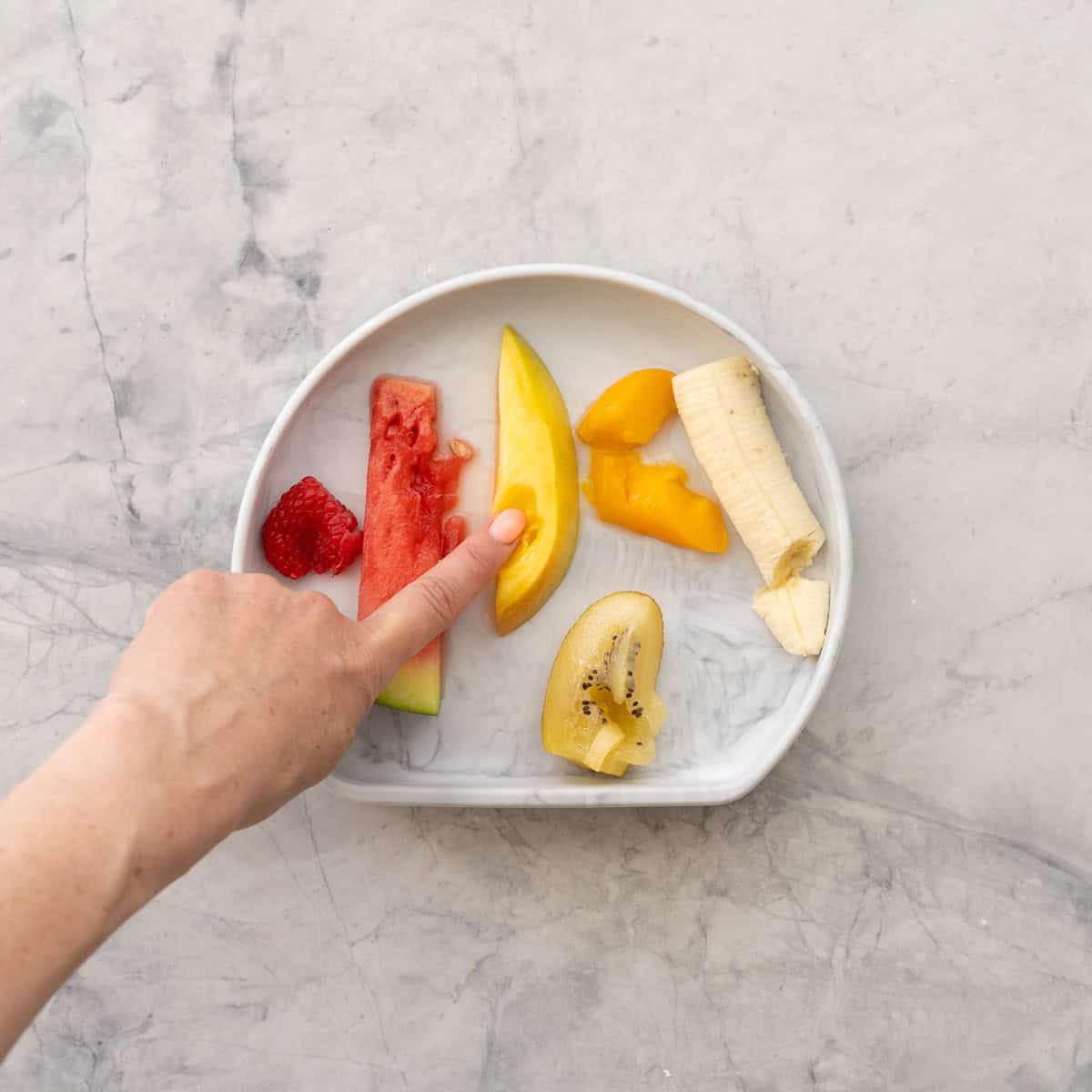
Shape Matters
Early on, babies use their whole hand to grab, so larger, stick-like shapes work best. As their pincer grasp develops (around 9 months+), you can offer smaller bite-sized pieces or soft diced fruit.
Fruits to Avoid (at First)
Some fruits are too hard or risky when raw — these include:
- Apples – hard and crunchy raw, which can pose a choking risk. See Apple in our guide for safe prep tips.
- Raw pear – can also be too firm unless fully ripe and soft.
- Grapes and cherries – always pit and cut lengthwise into quarters to reduce choking risk.
Skip dried fruit like sultanas or apple rings for now — they’re chewy and sticky, and not safe for early eaters.
Quick Tips
- Choose ripe, soft fruit that’s easy to squish.
- Cut to match your baby’s age and grasping skills.
- Always supervise, and let your baby explore at their own pace.
Fruit is often one of baby’s first true favourites — and with so many safe, squishy options, it’s a colourful way to build confidence and flavour familiarity!
G
Garlic
Garlic is safe for babies from around 6 months and can be a great way to add flavour to their meals. It’s not a common allergen and is generally well-tolerated when used in small amounts.
How to Use Garlic:
- Add a small pinch to meals like veggies, meats, or legumes
- Mix into mashed potato, lentils, or sauces for extra flavour
- Include in dips like hummus or tomato-based sauces
Start with just a little and see how your baby responds—some may experience mild gas at first. Garlic doesn’t offer major nutrients in small amounts, but it’s a great way to boost flavour without salt.
Save This Recipe!
Ginger
Ginger is safe to introduce from around 6 months and adds a warm, aromatic flavour to baby’s meals. It’s not a common allergen and is generally well-tolerated when used in small amounts.
How to Use Ginger:
- Add a tiny pinch of grated or ground ginger to dishes like stews, lentils, or porridge
- Stir into baby-friendly bakes like muffins or pancakes
- Use to gently flavour meals, not as a standalone ingredient
Start small—ginger has a bold flavour, so a little goes a long way. It’s been traditionally used to support digestion and is a great way to add depth without added salt or sugar.
Grapefruit
(refer citrus fruit)
Grapes
Whole grapes are not safe for babies—they’re a top choking hazard due to their round shape and slippery skin. Grapes can be safely offered from 6 months, but only when prepared carefully.
How to Serve Grapes Safely:
- Always cut lengthwise into quarters (never just in half)
- Choose seedless grapes and remove any tough skins
- For younger babies, you can mash or finely chop and mix into yoghurt or porridge
- Try freezing and finely grating grapes for a cool fruit slush
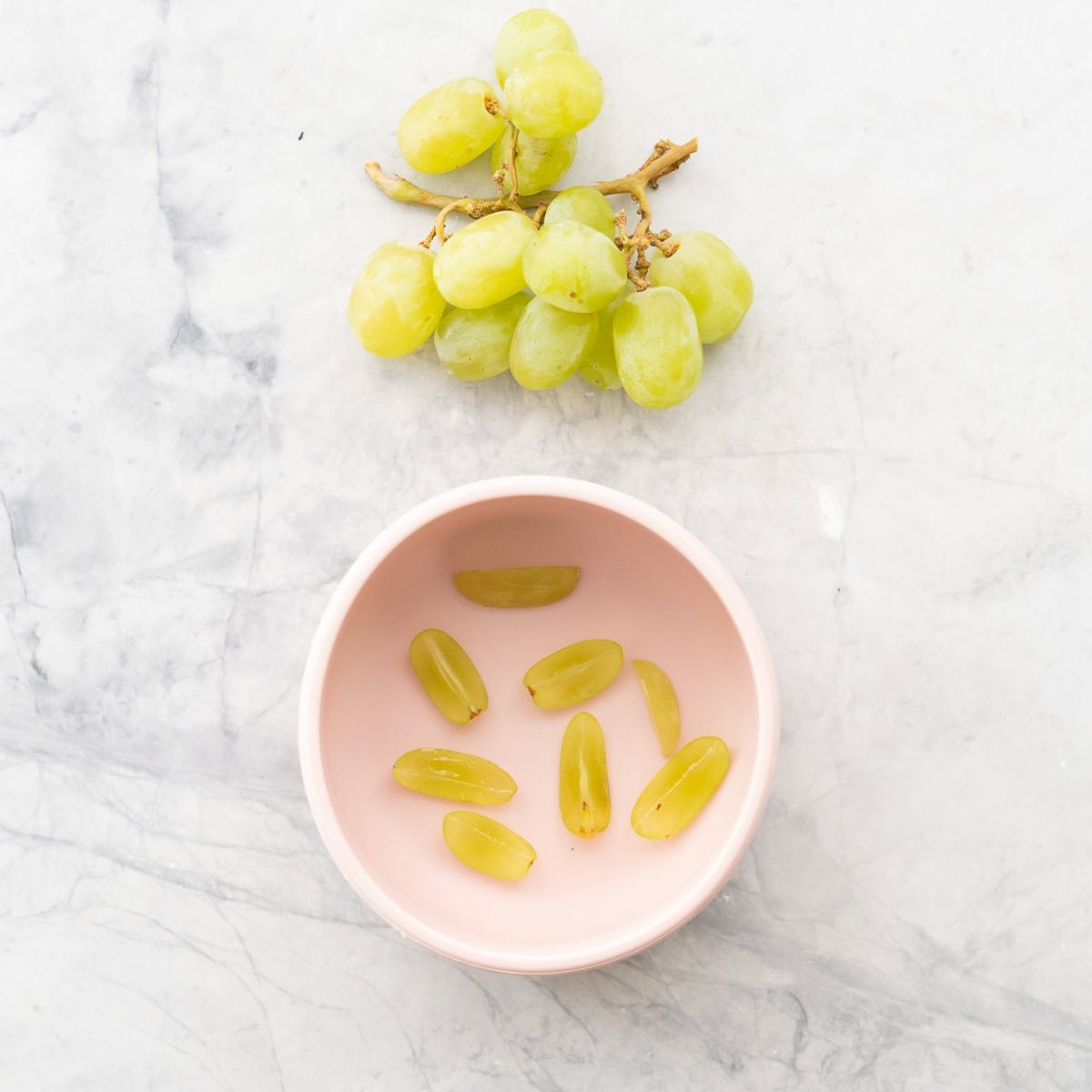
Green beans
Green beans are a great first finger food when cooked until very soft—they should squash easily with a fork. Firm or undercooked beans can be a choking risk, so make sure they’re well steamed or boiled.
How to Serve:
- Whole and soft – offer as finger food once bendy and mashable
- Chopped – mix finely chopped beans into mashed potatoes, eggs, or soft rice
- Mashed – blend into veggie mixes or spoon-fed meals

Green Leafy Vegetables
Cooked leafy greens like spinach, kale, bok choy, and chard can be safely introduced from around 6 months. They’re full of nutrients but can be tricky for babies to pick up, so they’re often best served mixed into other foods.
How to Serve:
- Finely chop and stir into scrambled eggs, pasta, or mashed veggies
- Mix into patties, fritters, or sauces
- Cook until wilted and soft for easier digestion and texture
Note: This section refers to cooked leafy greens. For raw salad greens, see Salad Greens.
H
Ham
(refer processed meats and sausages)
Hazelnuts
(refer nuts & seeds)
Hemp seeds
(refer nuts & seeds)
Herbs
Herbs are a fab way to add flavour to your baby’s food without salt or sugar. From around 6 months, you can start using small amounts of fresh or dried herbs to make meals more interesting—and help develop baby’s palate right from the start.
Easy Ways to Use Herbs:
- Finely chop fresh herbs into eggs, mashed veg, pasta sauces, or fritters
- Sprinkle a small pinch of dried herbs into cooking water or meals while they cook
- Use herb-infused oil or mild broth to gently flavour veggies or grains (no added salt!)
Baby-Friendly Herbs to Try:
- Basil – lovely with tomato or pasta or tomato pasta!
- Parsley – great with mashed spuds, eggs, or meat
- Coriander (cilantro) – delicious in lentil and veggie dishes
- Dill – perfect with fish or yoghurt
- Thyme & oregano – great in sauces, casseroles, or roasted veg
- Mint – pairs nicely with peas or yoghurt
Tip: Always skip woody bits and large leaves—no bay leaves or rosemary stalks in baby’s bowl!
Honey
Not safe for babies under 12 months.
Even in tiny amounts—even if it’s cooked or baked in. Honey can carry spores that may cause infant botulism, a rare but serious illness. Babies’ digestive systems aren’t ready to handle it yet.
This includes:
- Raw or pasteurised honey
- Organic or conventional
- Baked into muffins, cereals, or snacks
- Honey in cough syrups, teas, or traditional remedies
From 12 months onward, honey is safe, but still best used sparingly—it’s an added sugar, after all.
Safer ways to sweeten baby food:
- Mashed banana
- Stewed apple or pear
- A pinch of cinnamon
- A little cooked date purée (for older babies)
Honey dew
(refer melons)
Hot dogs
(refer Frankfurters and processed meats)
J
Jam
Not recommended for babies under 12 months.
Jam is high in added sugar, which babies simply don’t need. Even a small amount can exceed daily sugar limits and may impact tooth health and taste preferences long-term.
Why Skip It (for now):
- High in sugar
- Low in nutrition
- Often contains preservatives or additives
Health guidelines (like the NHS and NICE) recommend no added sugars before age 1. That includes jam on toast, in baking, or stirred into yoghurt.
After 12 Months:
If you do offer jam, go for 100% fruit spreads with no added sugar and use just a thin layer, paired with whole foods like grainy toast or plain yoghurt.
Better Baby-Friendly Alternatives:
- Mashed banana or berries
- Stewed apple or pear
- Blueberry Chia Jam – naturally sweet and no added sugar
- Homemade fruit purée or fruit-only spreads
Tip: Watch out for “low sugar” jams—they often contain artificial sweeteners, which aren’t suitable for babies either.

Jeruselum artichoke
(refer root vegetables)
K
Kale
(refer green leafy vegetables)
Kiwi fruit/Kiwi
Kiwi is a soft, juicy fruit that’s safe for babies from 6 months—as long as it’s ripe and peeled. It’s packed with vitamin C and has a fun tart-sweet flavour most babies enjoy. Just a heads-up: some little ones may get a mild rash around the mouth at first due to its natural acidity—but this often settles over time and isn’t usually a true allergy.
How to Serve Kiwi:
- Peeled and cut into wedges for early self-feeding
- Mashed or puréed and swirled through yoghurt or oats (try this kiwi purée)
- Thin slices for babies with a pincer grasp (around 9+ months)
Golden kiwis are usually sweeter and less acidic, which some babies prefer.
Kiwi isn’t a common choking risk when soft and ripe, but make sure it gives slightly to pressure and always peel before serving.
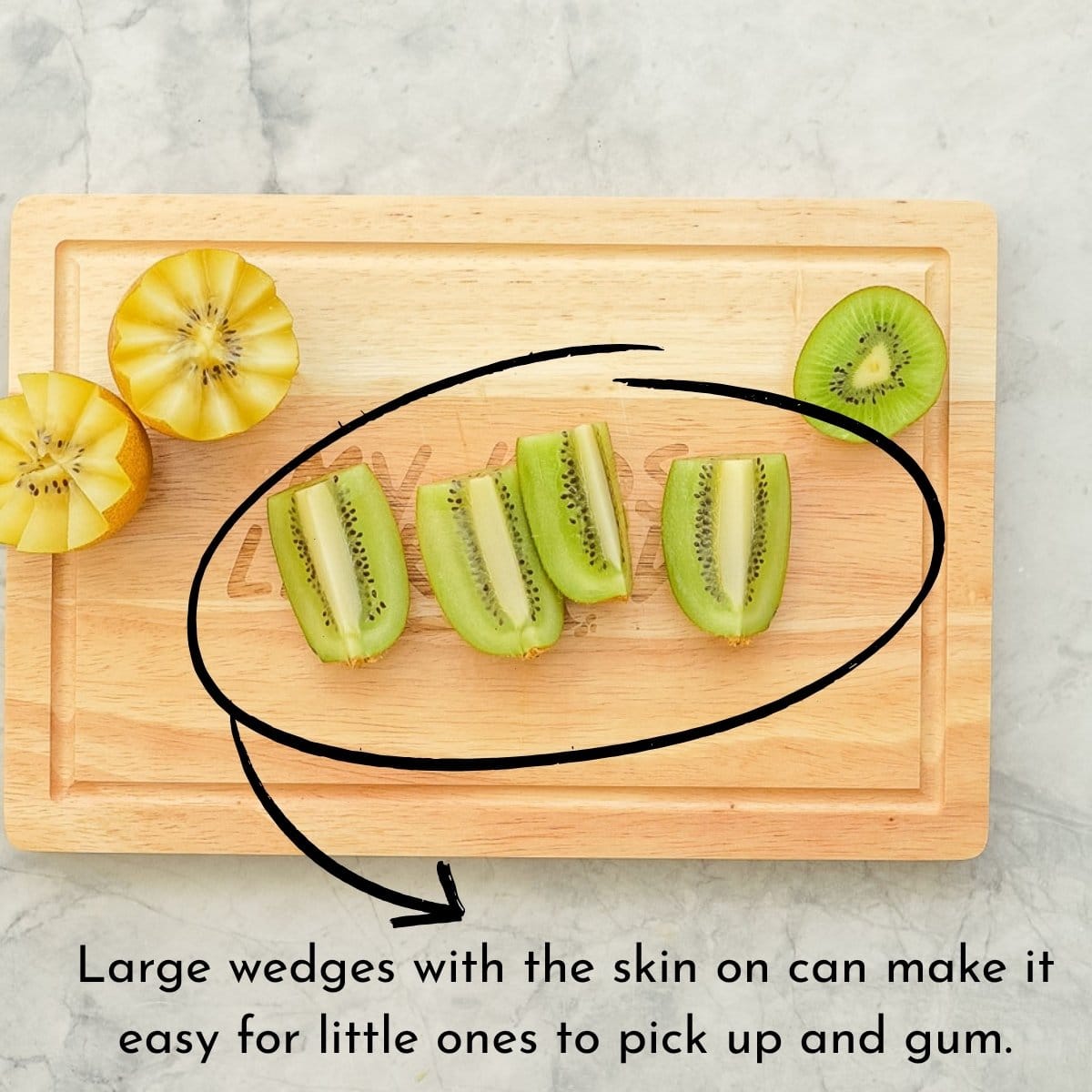
Kumara/Sweet Potatoes
(refer root vegetables)
L
Lamb
(refer meat and poultry)
Lettuce
(refer salad greens)
Leeks
Leeks are a gentle, sweeter cousin to onions and a great way to add flavour to your baby’s meals. When cooked until soft, they’re safe from around 6 months and easy to mix into family-friendly dishes.
How to Serve:
- Soft leek rings or batons – steam or sauté until tender
- Finely chopped or mashed – stir into mashed potatoes, lentils, or omelettes
- Baked into dishes – perfect in fritters, muffins, or sauces
Just be sure to cook them well—undercooked leeks can be stringy and hard to chew.
Leeks aren’t a common allergen, but like other alliums (onion, garlic), they may cause a little gas at first. Start small and see how your baby goes.
Try them in these BLW-friendly family meals:
Legumes
(refer Beans Peas Lentils Pulses)
Lemon
(refer citrus fruit)
Lentils
(refer Beans Peas Lentils Pulses)
Liver
Beef, Chicken or Lamb
Liver is a super nutrient-dense food—packed with iron, vitamin A, and other goodies babies need from around 6 months. It’s especially helpful for little ones who might need a boost in iron. Just remember, a little goes a long way—too much vitamin A isn’t ideal, so liver is best served in small amounts, no more than once a week.
How to Serve Liver:
- Cooked and sliced – pan-fry or bake thin slices, then cut into finger-sized strips
- Mashed or blended – mix into mashed veg or lentils for spoon-feeding
- In patties or meatballs – blend with minced meat to mellow the flavour
Make sure it’s fully cooked through (no pink) and kept moist—overcooked liver can get dry and crumbly.
Liver isn’t a common allergen, but the strong taste can be hit-or-miss. Mixing it into familiar dishes can help ease your baby into it.
Skip liver pâté—it often contains added salt or unpasteurised ingredients, which aren’t suitable for babies
Lobster
(refer shellfish)
Lychees
Lychees are juicy and sweet, but they need careful prep to be safe for babies. Never serve them whole—even peeled, they’re round and slippery, making them a choking hazard.
How to Serve Safely:
- Use only ripe lychees (soft and plump)
- Peel, remove the seed, and check for any tough bits inside
- Cut into small pieces—especially for babies under 12 months
- Mix into yoghurt or serve with soft fruits like banana or pear
M
Macadamia nuts
(refer nuts & seeds)
Mangoes
Mango is a perfect first fruit—naturally sweet, soft, and full of vitamin C. It’s safe from 6 months when ripe and cut the right way.
How to Serve:
- Peeled strips – cut into thick, grabbable pieces
- With skin on for grip – slice off a cheek, score the flesh, and leave the skin on (watch baby closely to avoid skin bites)
- Mashed or puréed – great in yoghurt, porridge, or on a pre-loaded spoon
- Chopped – add to pancakes, muffins, or chia pudding
Fun tip: The mango pit (after removing all skin) makes a great natural teething rusk—slippery, sweet, and soothing on sore gums!
Skip dried mango—it’s sticky and a choking risk for little ones (see the dried fruit section for more info.).
Mandarins
(refer citrus fruit)
Maple syrup
Not recommended for babies under 12 months.
Even though it’s natural, maple syrup is still added sugar, and babies don’t need it. Health guidelines recommend avoiding added sugars in the first year to support healthy growth, teeth, and eating habits.
After 12 Months:
A small drizzle now and then is okay—for example, in baking or on pancakes. Just stick to 100% pure maple syrup and keep it occasional.
Better Sweetness for Babies:
- Mashed banana
- Stewed apple or pear
- A pinch of cinnamon or vanilla
If a recipe calls for maple syrup, you can often swap it for mashed banana or apple purée for babies under 1.
Marshmallows
Not safe for babies—do not offer under any circumstances.
Marshmallows are a serious choking hazard. Their soft, sticky, squishy texture makes them one of the highest-risk foods, according to the American Academy of Pediatrics.
They also offer zero nutritional value—just sugar, additives, and sometimes allergens like egg or gelatine.
Why Avoid:
- High choking risk (similar to whole grapes and hot dogs)
- Very high in sugar
- No benefit for baby’s diet
- May contain gelatine, artificial colours, or sweeteners
Even for older kids, marshmallows should be served with caution and close supervision.
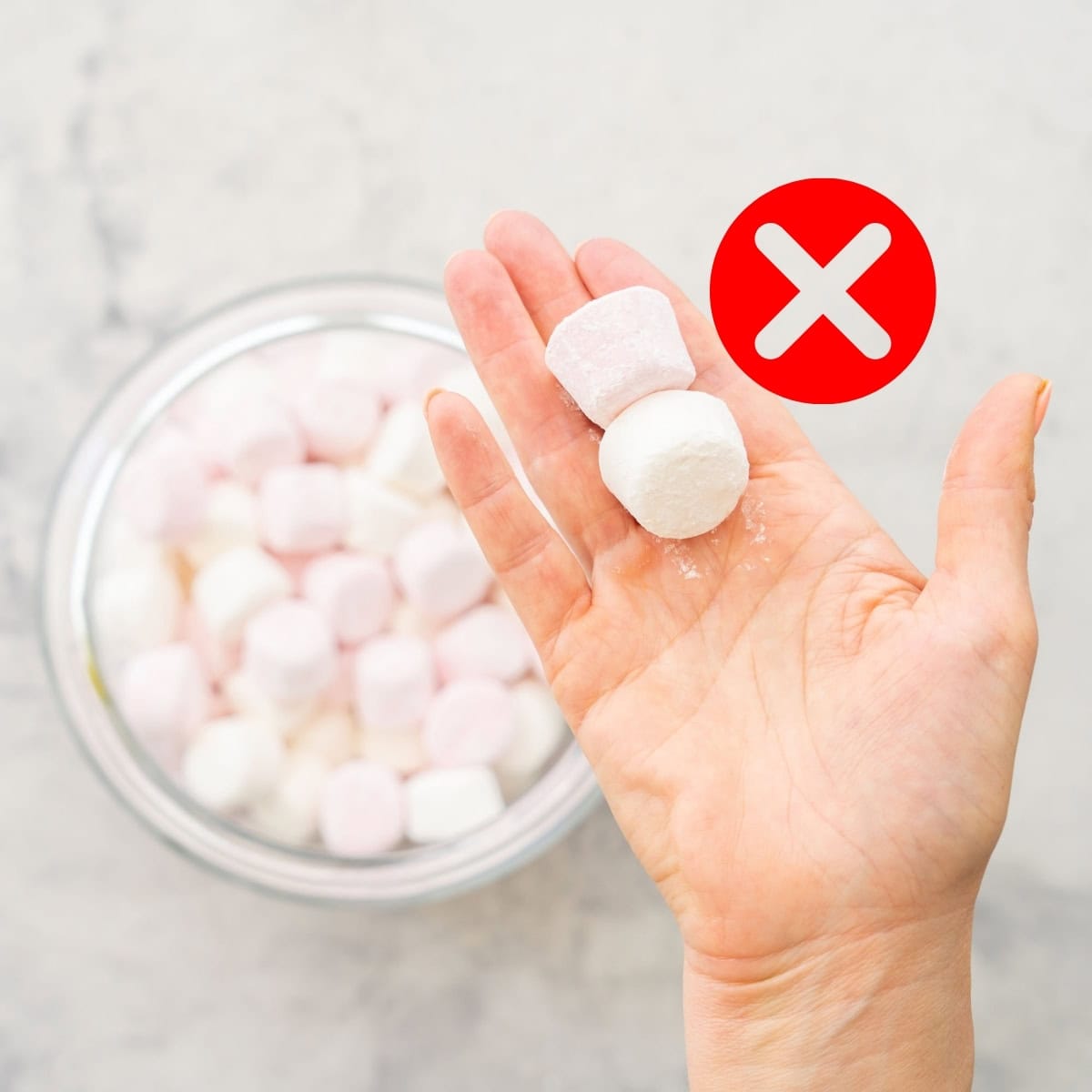
Meat and poultry
Fresh meats like chicken, beef, lamb, turkey, and pork are excellent sources of iron and B vitamins and protein. The trick is serving them safely and in a way that your baby can manage with their gums (yes, even if they don’t have teeth yet!).
Processed meats are a different story, they are high in salt and in some presentations can be a choking risk, so please check out the processed meat section for more information.
How to Serve Meat and Poultry Safely
Here’s the key: texture and shape matter. Meat should be tender enough for your baby to suck and gnaw on, and the shape should allow them to grasp it easily — either as a “meat handle” or in soft, easy-to-pick-up pieces.
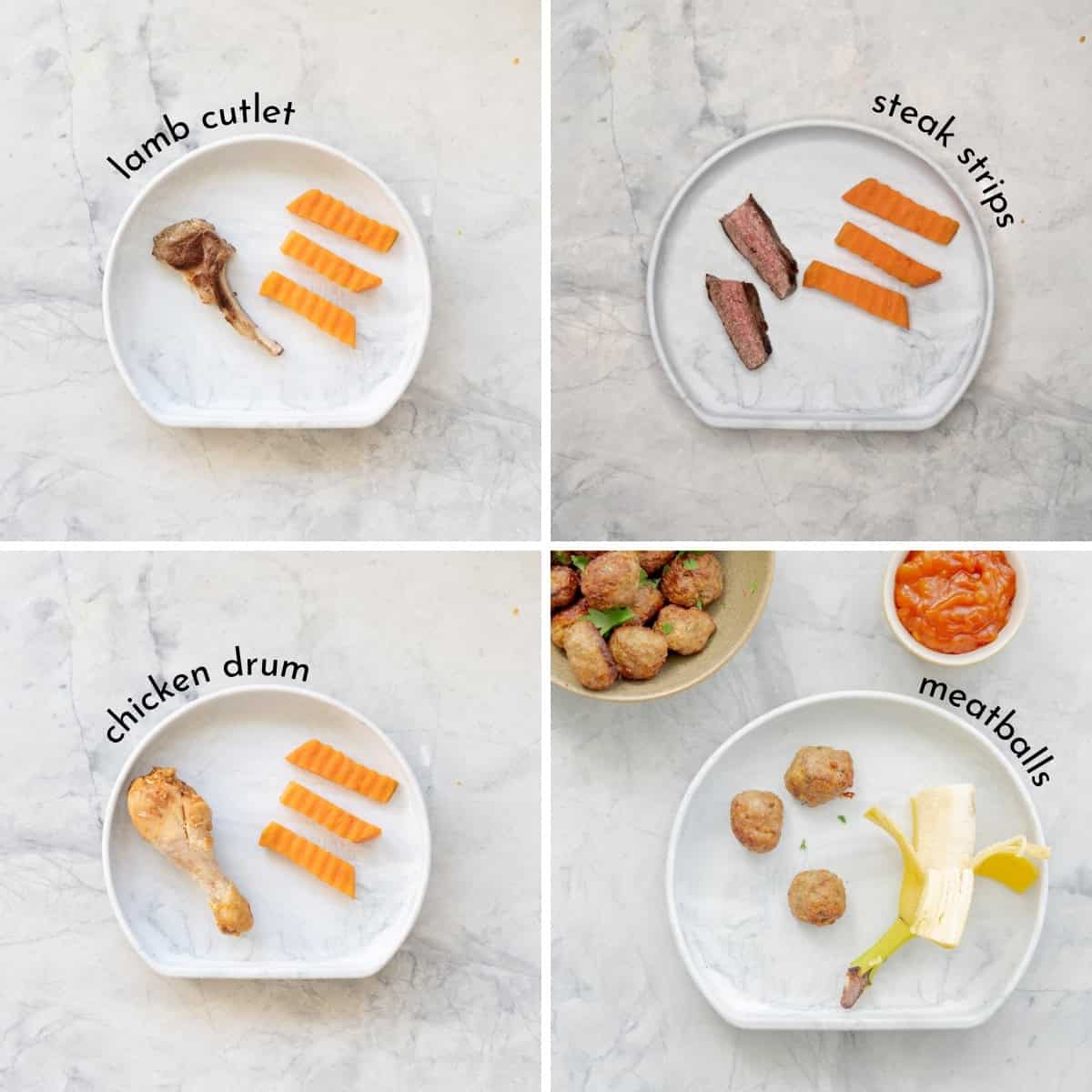
1. Strips and ‘Meat Handles’
For whole cuts of meat, think long finger-sized strips or cuts with a natural handle.
- Steak strips: Slice cooked steak against the grain into long pieces so it’s easier for baby to suck and chew.
- Lamb cutlets or chops: These are brilliant because the bone forms a natural “handle.” Just trim off any sharp bits, and ensure the meat is soft and cooked to tender.
- Chicken drumsticks: Another great meat handle! Be sure to remove the skin and check carefully for the tiny pin bone that sometimes hides inside.
These types of cuts allow babies to explore flavour and texture, and they’ll gnaw, suck, and bite off small pieces at their own pace — perfect for BLW.
2. Minced Meat Recipes (Great for Beginners)
Minced meat is ideal for forming into soft, tender pieces that baby can pick up. Cooking meat this way keeps it moist and reduces any choking risk when compared to dry or stringy cuts.
You might like to try these baby-friendly recipes from my site:
- Chicken Meatballs – Tender and mild, great for little hands.
- Baked Beef Meatballs – Oven-baked for a soft texture and no frying fuss.
- Beef and Vegetable Rissoles – A great way to get some hidden veggies in there too.
- Chicken Patties – Perfect for batch cooking and freezing.
- Beef Burgers without Egg or Breadcrumbs - The perfect allergy friendly burger recipe
These are all shaped into baby-sized portions and cooked until soft — great first meat options!
Tips for Serving Meat to Babies
- Cut appropriately: As your baby gets older and more skilled, you can change the size and texture. Start big and soft, then adjust as they grow.For BLW, serve meat in soft, slow-cooked forms like shredded chicken, tender strips of roast meat, or meatballs. Avoid tough cuts or very dry preparations. Ground meats work well in patties, meatballs, or Bolognese-style sauces. Always cook meat thoroughly and avoid adding salt.
- Moisture is your friend: Dry meat is tough for babies to manage. Braising, slow-cooking, or serving meat with a little sauce can help.
- No added salt: Babies’ kidneys can’t handle too much salt, so skip the seasoning or use baby-safe stock.
- Always supervise: Especially with meat on the bone like drumsticks or cutlets — be right there to keep an eye out.
Melons
Melons are a great first fruit for baby-led weaning—soft, juicy, and naturally sweet. They're also hydrating and packed with nutrients like vitamin C and beta-carotene. You can offer melons like honeydew, rockmelon (cantaloupe), and watermelon from 6 months, as long as they’re ripe and safely prepared.
How to Serve Melon Safely
- Large spears or wedges with the rind on (6–9 months): Easy for babies to grip while they gnaw the soft flesh. Always supervise and remove if it gets too small.
- Peeled chunks or small pieces (9+ months): Great once your baby develops a pincer grasp.
- Mashed or finely chopped: Stir into yogurt, porridge, or smoothies.
- Frozen and thawed: A cool option for teething relief—just make sure the texture is soft, not icy.
Safety Tips
- Always serve fully ripe melon—underripe pieces can be firm and harder to chew.
- Avoid melon balls and firm cubes for young babies—they’re slippery and round, which increases choking risk.
- Remove all seeds from melons
- Supervise closely and don’t let babies gnaw the rind unless they’re older and can manage it well.
Parent Tips
- Wash melon rinds before cutting—melons can carry bacteria like Listeria on the skin.
- Choose melons that smell sweet and feel slightly soft at the stem end.
- Store cut melon in the fridge and use within 2 days.
- Cold melon can be great for teething—check out more ideas in Soothing Foods for Teething Babies.

Milk
Cow’s milk isn’t recommended as a main drink before 12 months, but small amounts are safe to use in cooking from around 6 months.
You can mix a little into foods like:
- Baby Porridge or cereal
- Scrambled eggs
- Cheese sauce or mashed potato
- Pancakes or baking
From 12 months, full-fat cow’s milk can be offered as a regular drink if your baby is no longer breastfeeding or using formula.
For more about introducing dairy (including milk, cheese, yogurt, and allergy info), see the Dairy section of this guide.
Avoid before 1 year:
- Skim or low-fat milk
- Flavoured milks (too much sugar)
- Raw or unpasteurised milk
Allergy note: Cow’s milk is a common allergen. Start with small amounts of dairy and watch for signs of a reaction.
Molasses
Not recommended for babies under 12 months. While it contains some iron and minerals, it’s still an added sugar, which babies don’t need.
Molasses is sticky, sweet, and strong in flavour—it can stick to gums and teeth, and isn’t ideal for tiny tummies. Health guidelines advise avoiding added sugars before 1 to help prevent tooth decay and a sweet tooth.
After 12 months, it’s okay to use a tiny amount in things like muffins or baked beans, but it shouldn’t be used often. Always choose unsulphured molasses if using.
Looking for iron? Safer options include meat, lentils, tofu, eggs, and iron-fortified cereals—paired with fruit or veggies for better absorption
Mushrooms
Safe from 6 months when fully cooked and served in baby-friendly shapes.
Mushrooms are soft, savoury, and full of nutrients when cooked. Raw mushrooms aren’t suitable—they’re hard to chew, harder to digest, and can carry bacteria. Only offer store-bought mushrooms, never wild ones (they can be toxic).
How to Serve:
- Sauté or roast button, portobello, or cremini mushrooms until soft. Cut into thin strips or bite-sized pieces.
- Mix finely chopped or grated into omelettes, pasta, or lentil dishes.
- Stuffed mushrooms can be fun for older babies—fill with soft veg, rice, or lentils.
Safety Tips:
- Always cook until soft enough to mash between your fingers.
- Avoid chewy or rubbery textures (like grilled mushrooms that aren’t fully cooked).
- Cut large mushrooms into thin, easy-to-handle pieces.
Mustard
Commercially prepared mustards are typically Not suitable for babies under 12 months.
Even a small amount of prepared mustard can exceed safe sodium levels. Wait until after 1 year, and if using, offer only a tiny amount mixed into family meals.
Safer ways to add flavour? Try herbs, mild spices, or cooked onion and garlic.
In some countries, Mustard is a common allergen and needs to be labeled in the UK, EU, and Canada
N
Nectarines
Nut butter
(refer nuts & seeds)
Nuts & Seeds
Whole nuts are a choking hazard and should not be given to babies. But that doesn’t mean nuts and seeds are off the menu—there are safe, nutritious ways to include them in your baby’s diet from 6 months, and doing so can help with early allergy prevention.
Nut Butters (Peanut, Almond, Cashew & More)
Nut butters are one of the safest and easiest ways to introduce nut allergens.
- Use smooth, unsweetened nut butters (no added sugar or salt).
- Serve thinly spread on toast fingers, soft pancakes, or stirred into porridge, yoghurt or mashed banana.
- Avoid thick spoonfuls—large globs can be sticky and hard to swallow for babies.
Introduce one type of nut at a time and watch for any signs of allergy (rash, swelling, vomiting, etc). If there’s a family history of food allergies, check with your healthcare provider first.
Whole Nuts
These should be avoided in babies and toddlers due to choking risk. Once your child is 3+ years and can chew well, whole nuts may be introduced safely under supervision.
Seeds (Chia, Flax, Hemp, Pumpkin, Sunflower)
Seeds can offer healthy fats, fibre, and minerals. Here’s how to use them safely:
- Chia, flax, or hemp seeds: Sprinkle small seeds into porridge, yoghurt, or smoothies. Soaking chia seeds first can improve texture and digestion.
- Pumpkin and sunflower seeds: Offer ground or very finely chopped only—whole large seeds are a choking risk.
- You can also add seed blends into fritters, baking, or veggie patties for a gentle nutrition boost.
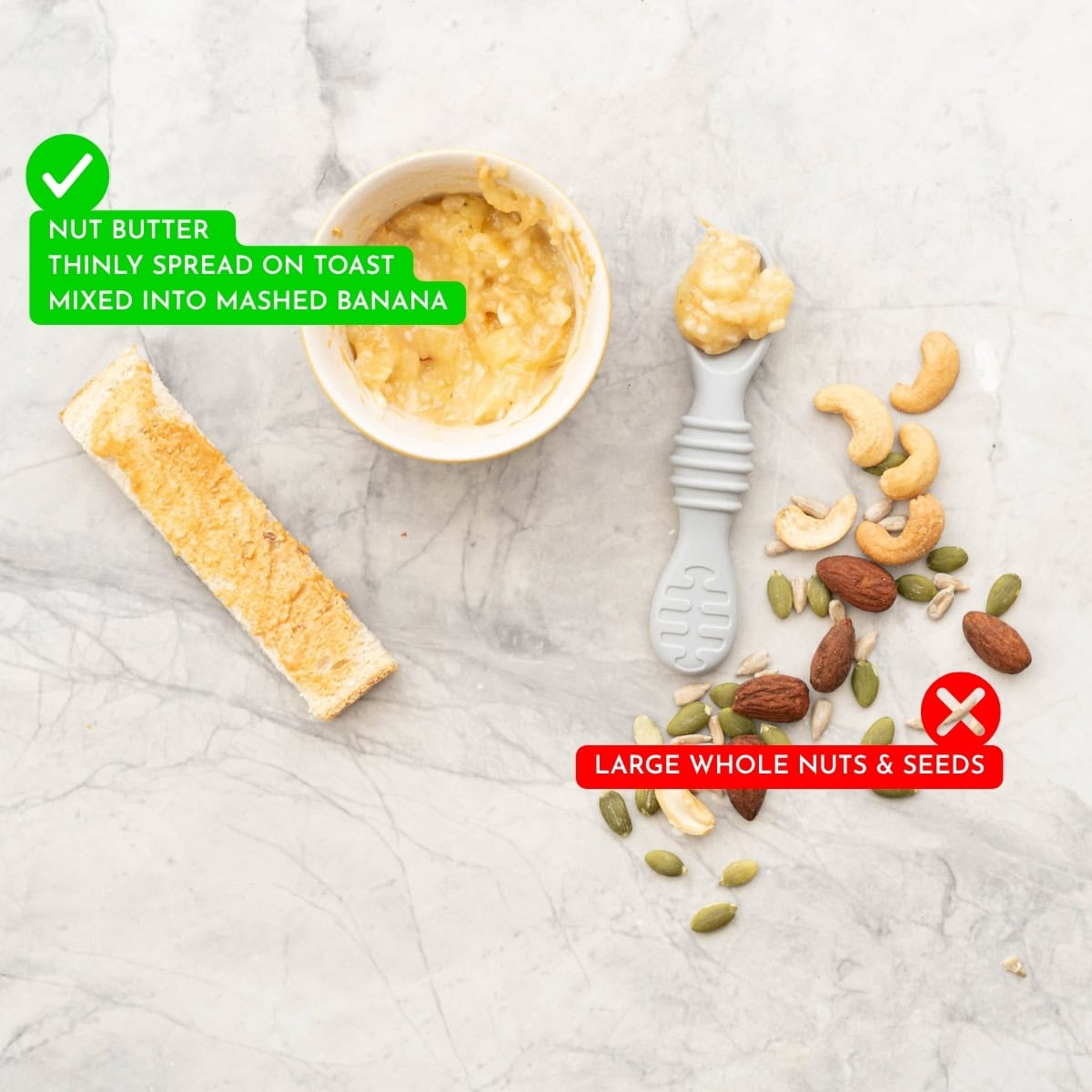
O
Oatmeal / oats
Oats are a BLW staple — gentle on little tummies, packed with nutrition, and easy to serve in loads of baby-friendly ways.
Are Oats Safe for BLW?
Yes — from 6 months, as long as they’re prepared with the right texture. They’re soft, easy to digest, and not a choking hazard when cooked properly. Oat allergies are rare, but possible.
Easy Ways to Serve Oats
- Thick porridge (oatmeal): Cook with water, breast milk, or formula. Offer on a pre-loaded spoon or let baby scoop with hands.
- Baked oat bars or fingers: Mix oats with mashed banana or apple and bake into soft, grabbable bars.
- Oat pancakes: Blend oats into pancake batter with fruit, veg, or egg.
- Overnight oats (for older babies): Soaked oats mashed with soft fruit, served cold or warm.
Use rolled or quick oats for most baby recipes. Steel-cut oats take longer and may need blending.
Choking & Texture Tips
- Cook oats until soft.
- Avoid dry, crumbly textures (e.g. granola).
- Finger foods should be soft and moist enough to mash with gums.
Nutritional Benefits
- Rich in fibre (great for digestion)
- Contains iron, magnesium, and B vitamins
- Slow-release energy to keep baby full
Pair oats with vitamin C-rich fruits (like strawberries or kiwi) to boost iron absorption.
Baby Led Weaning Recipes Using Oats
Here are some tried-and-true oat recipes that babies love:
Olives
Olives can work for BLW with care — they’re soft and full of flavour, but also salty and a potential choking risk if not prepared properly.
Safety Notes
- Always pitted — even "pitted" olives can have fragments.
- Chop finely or slice into rings to reduce choking risk.
- Always low-sodium and serve in small amounts, occasionally.
How to Serve
- Finely chopped into pasta, couscous, or veggie patties.
- Thin rings for older babies (9–12 months+).
- Homemade tapenade spread on toast fingers.
Olives aren’t an everyday food for babies, but a little goes a long way in adding flavour and variety.

Omelettes
(refer to eggs)
Onions
Cooked onions are safe from 6 months and can add a big flavour boost to baby meals — just make sure they’re soft and well-cooked. Raw onions are too harsh early on and can upset little tummies.
How to Serve
- Sautéed or roasted: Cut into strips or wedges and cook until very soft.
- Finely chopped & cooked: Stir into scrambled eggs, lentils, stews, or soups.
- Caramelised: Slow-cooked (no added sugar/salt) for a sweet, baby-friendly flavour.
- Baked: Mix into muffins, fritters, or veggie patties.
Safety Tips
- Always cook until soft and translucent.
- Avoid raw, stringy bits or large chunks.
- Start small to check for tummy tolerance.
Onions might not be the star of the plate, but they’re a great base for baby-friendly flavour!
Oranges
(refer to citrus fruit)
P
Parsnips
(refer to root vegetables)
Passion fruit
Passionfruit isn’t suitable for baby led weaning due to the large number of small, hard seeds. These can be a choking risk and are difficult for babies to manage safely
Pasta and Noodles
Pasta and noodles are great for self-feeding — soft, easy to hold, and perfect for catching sauce. Cook until very soft (not al dente), skip the salt, and serve plain, with a drizzle of oil, or coated in sauce.
Choose baby-friendly shapes like fusilli or penne that are easy to grasp. For long noodles like spaghetti or udon, cut into shorter strands to help babies handle them more easily and reduce gagging.
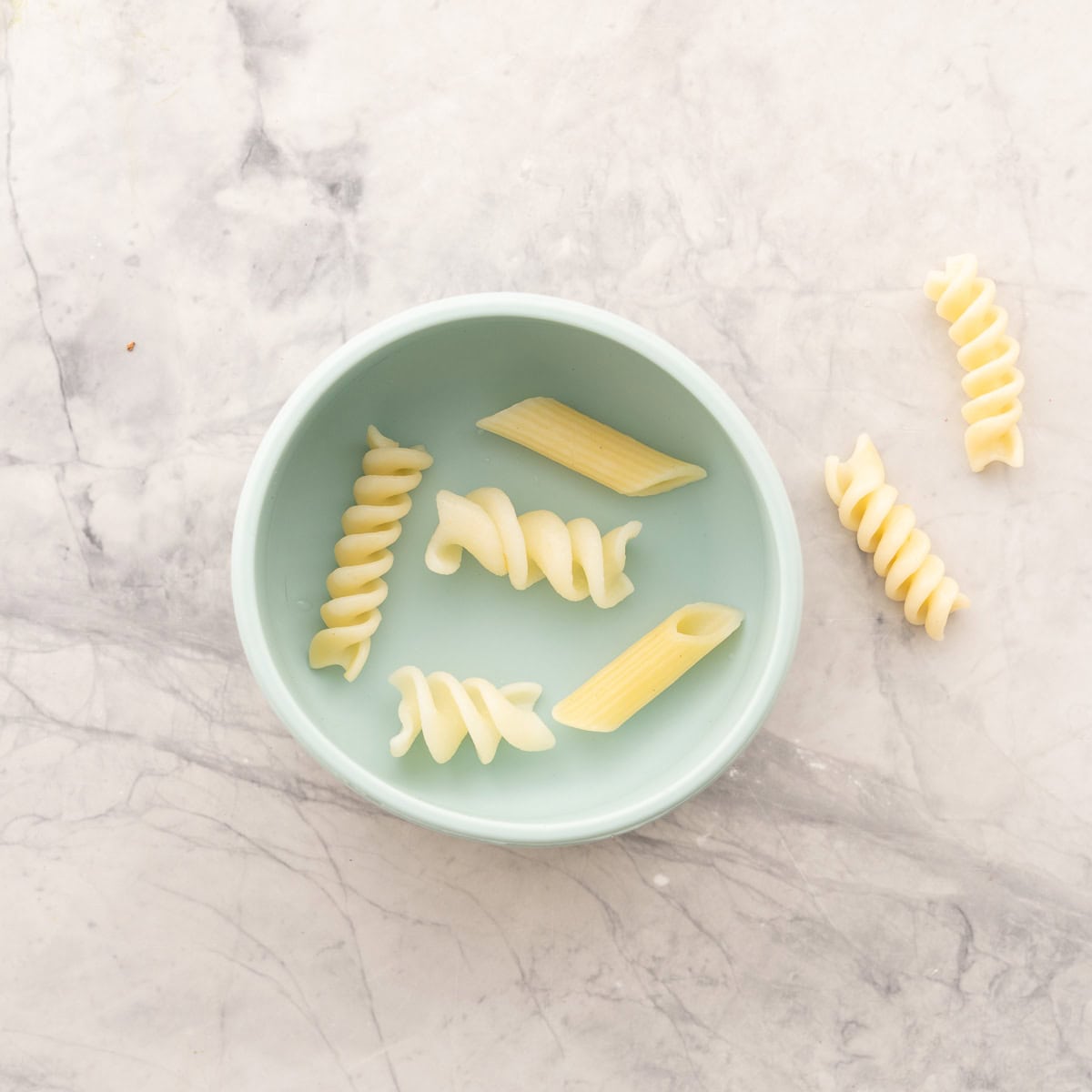
Baby Led Weaning Pasta Recipes
Peaches
Peanuts
(refer to nuts & seeds)
Peanut Butter
(refer to nuts & seeds)
Pears
Peas
Peas are sweet, soft, and packed with nutrients — great from 6 months when cooked until soft. But because they’re small and round, it’s best to mash or squash them for younger babies to reduce choking risk.
- Mashed: Lightly mash cooked peas and mix into potato, rice, or lentils. (Try our Mashed Peas recipe.)
- Pre-loaded spoon: Serve as a mash or purée for self-feeding.
- Mixed into soft foods: Stir into scrambled eggs, pasta dishes like Pea Pesto Pasta, or veggie slice.
- Whole peas: From around 9–10 months, older babies with a good pincer grasp may manage soft, whole peas — still supervise closely.
- In fritters: Great added to soft, baby-friendly fritters like my Pea Fritters.
Quick Tips
- Always cook peas until soft — boil or steam frozen peas.
- For babies under 9 months, mash before serving.
- Avoid raw or dry peas.
Pecans
(refer to nuts & seeds)
Persimmons
(refer to fruit)
Always serve very ripe, peeled slices: Cut into thick wedges or strips that baby can easily grasp. Flesh should be soft and jelly-like.
Pickles
Pickles aren’t suitable for babies under 12 months due to high salt content and potential choking risk. Even a few bites can exceed a baby’s daily sodium limit.
If Offering After 12 Months:
- Choose low-sodium, unsweetened options
- Slice thinly and rinse to reduce salt
- Offer only occasionally and with low-salt foods
Pineapple
(refer to fruit)
Safe from 6 months when ripe, soft, and served appropriately. Mild acidity may cause temporary irritation.
Pine nuts
(refer to nuts & seeds)
Pistachio
(refer to nuts & seeds)
Plantains
Plantains are safe from 6 months — just make sure they’re cooked until soft. Unlike bananas, plantains are firmer and starchier, so they must be steamed, boiled, baked, or pan-fried (no salt) before serving.
How to Serve
- Steamed or boiled in wedges or strips
- Mashed with breastmilk, yoghurt, or beans
- Baked or roasted until soft and golden
- Lightly pan-fried in oil, no seasoning
Skip raw plantain and avoid commercial chips — they’re too tough and salty. Soft-cooked plantain is a tasty, nutrient-rich way to add variety to your baby’s plate!
Plums
(refer to fruit)
Polenta
Polenta is safe from 6 months and makes a great first food when cooked until soft. It’s naturally gluten-free, easy to digest, and can be served creamy or in sliceable pieces for little hands to grab.
How to Serve
- Creamy: Cook with water or full-fat milk (if introduced) and serve on a pre-loaded spoon.
- Set and slice: Let it firm up, then cut into fingers or wedges.
- Baked or pan-fried: For older babies, lightly crisp slices (no salt or seasoning).
- Mix in soft veg, beans, or lentils for extra nutrition.
Pomello
(refer to citrus fruit)
Popcorn
Not safe for babies or toddlers under 4 years old. Popcorn is a major choking hazard — even fully popped pieces can have hard bits or dry, crumbly textures that are dangerous for young children.
Why Avoid It?
- Top choking risk, per AAP guidelines
- No safe way to serve it for BLW
- Store bought versions are often high in salt as well.
Popcorn can wait — save it for when your child is older and can chew safely with supervision.
Pork
(refer to meat and poultry)
Potatoes (refer to root vegetables)
Potatoes are safe from 6 months when cooked until soft and served without added salt. They’re filling, versatile, and easy for babies to handle.
For full serving ideas, check out the Root Vegetables section — potatoes can be prepared in similar baby-friendly ways.
Processed meat and Sausages
Processed meats like ham, bacon, salami, hot dogs, frankfurters, and chorizo are not recommended for babies — especially under 12 months.
They’re often very high in salt and preservatives, which babies' kidneys can’t handle. Some, like hot dogs and frankfurters, also pose a serious choking risk (see my Hot Dogs section for more on that).
What to Do Instead
Skip the deli meats and go for fresh, home-cooked meats with no added salt. Simple chicken, beef, or lamb — cooked until tender — is much safer and more nutritious for little ones. Homemade meatballs or patties are great options too (see our Meat and Poultry section for ideas).
Prunes
(refer to dried fruit)
Pumpkin
(refer to root vegetables)
Pumpkin seeds
(refer to nuts & seeds)
Q
Quail
(refer to meat and poultry)
Quince
(refer to fruit)
R
Radicchio
(refer to salad greens)
Radishes
Raw radishes are not safe for babies due to their hard, round shape and sharp flavour. But once cooked until soft, they become mild and tender — safe to offer from 6 months in baby-friendly shapes like strips or mash. Always skip raw slices and serve cooked only.
Raisins
(refer to dried fruit)
Ramen
(refer to pasta & noodles)
Ramen isn’t suitable for babies under 12 months in its usual form — the broth and flavour packets are far too salty and often contain additives. While the noodles can be made baby-friendly when plain and cut into short lengths, traditional ramen as a whole is best avoided.
For noodle ideas, see my Pasta and Noodles section.
Raspberries
(refer to berries)
Rhubarb
Rhubarb isn’t recommended for babies under 12 months. It’s very sour, often needs added sugar to be palatable, and contains oxalates that may irritate the digestive system. While cooked stalks can be safe for older children, the leaves are toxic, and the texture can still be tricky for babies. Best to wait and stick with gentler fruits and veggies in the first year.
Rice
Rice is safe from 6 months when it’s well-cooked and soft. It’s easy to digest and super versatile — think sticky grains, rice balls, or even soft risotto. Just remember rice is low in iron, so it’s best paired with iron-rich foods like meat, beans, or lentils.
How to Serve Rice
- Sticky or moist rice: Easy to scoop with hands. Try our Basmati Rice or Sushi Rice (skip the vinegar and salt).
- Rice balls or patties: Mix with tuna, chicken, or veg and shape into grabbable pieces. Try Tuna Rice Balls or Sushi Balls.
- Pre-loaded spoon: Great for rice porridge or congee.
- Mixed dishes: Soft risottos are perfect — check out Chicken & Leek Risotto, Pumpkin Risotto, or Mushroom Risotto.
Safety Tips
- Serve soft, moist rice — not dry or loose grains.
- Skip rice crackers or puffed rice cakes under 12 months unless softened.
- In some countries the arsenic levels in rice can be a concern, if this is a concern for you rinse rice well and cook in extra water to reduce arsenic. Mix it up! Offer other grains too (like oats, quinoa, couscous) to keep meals varied and reduce arsenic exposure over time.
Root Vegetables
Root veggies like carrots, sweet potato, beetroot, parsnip, and squash are perfect for baby-led weaning — as long as they’re cooked until soft and easily squishable between your fingers.
How to Serve
- Cut into thick sticks or wedges for easy grabbing.
- Cook by roasting, steaming, or boiling until soft all the way through.
- Try a crinkle cutter to add texture and make pieces less slippery for little hands.
- Grate or shred raw root veg like carrot into muffins, patties, or porridge for texture and flavour.
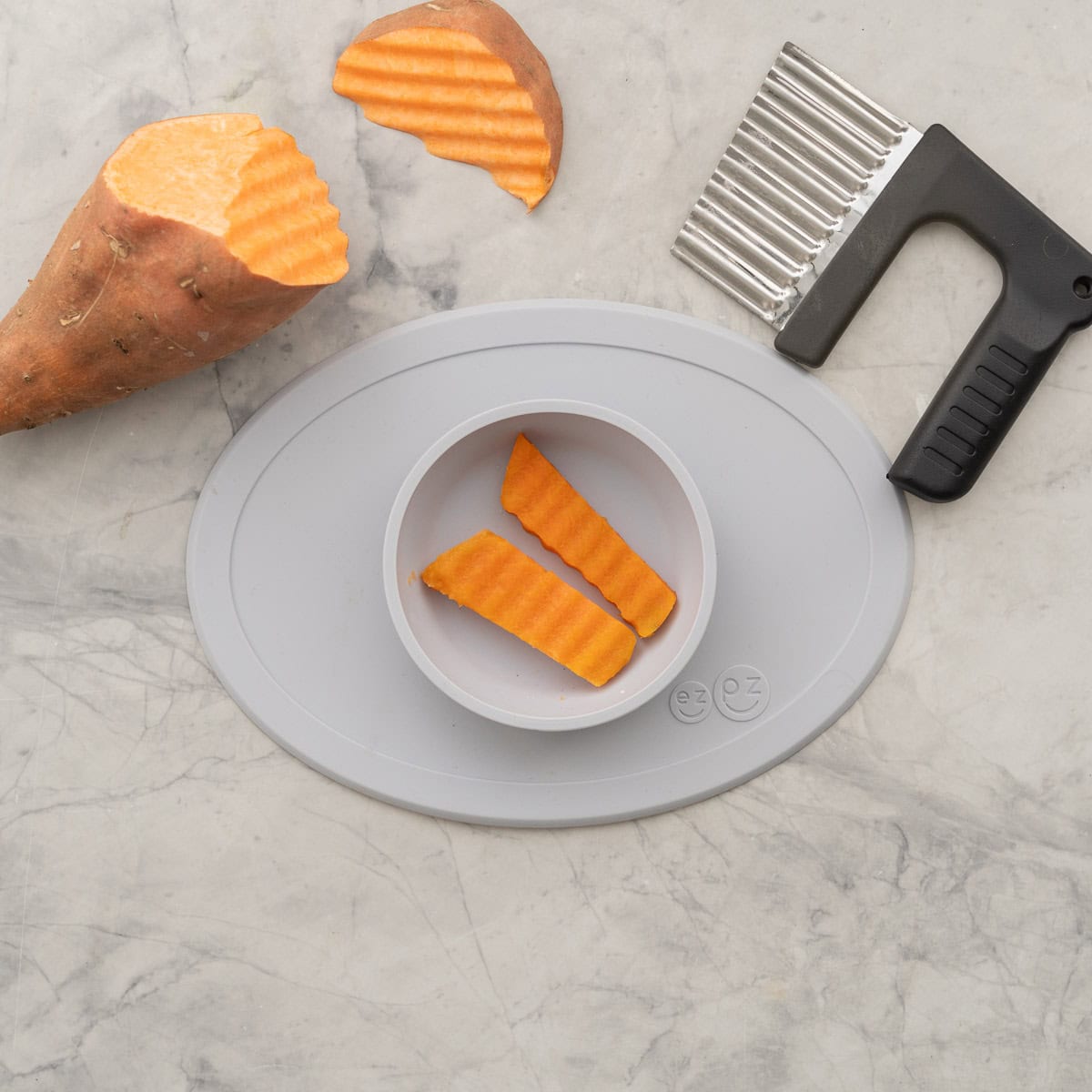
Important Safety Notes
- Avoid raw carrot sticks or other firm, uncooked root veg early on — they’re a choking risk.
- Always check that veggies are soft enough to mash between your fingers before serving.
Don’t forget, starchy vegetables like potatoes and pumpkin behave like root veg when cooked.
BLW Recipes Using Root Vegetables
Rockmelon/cantaloupe
(refer to melons)
S
Salmon-fresh
Salmon-smoked
Smoked salmon is not recommended for babies under 12 months due to its high salt content and the risk of foodborne illness (like listeria). It can also be chewy or stringy, which may increase the risk of choking.
Instead offer soft, fully cooked fresh salmon (steamed, baked, or pan-fried with no added salt). Flake it into small pieces — it's a great source of protein and omega-3s for babies from 6 months.
Salad greens
Lettuce, arugula, and radicchio are soft and delicate, but can be tricky for young babies to manage due to their slippery texture and lack of chew resistance. You can introduce them finely shredded and mixed into dishes (like omelettes or sandwiches) or wait until your baby has more experience with chewing and swallowing before offering them in larger pieces.
Salt
Salt should be completely avoided for babies under 12 months. Their kidneys are still developing and can’t handle extra sodium — even small amounts can exceed their daily limit.
Why It Matters
- Babies only need less than 1g of salt per day (about 0.4g sodium)
- Too much salt can strain their kidneys and affect blood pressure later in life
- Breastmilk, formula, and whole foods already provide enough sodium — no need to add more
Hidden Salt Sources to Avoid
- Stock cubes, sauces, gravies
- Smoked and processed meats (ham, bacon, sausages)
- Cheese (small amounts only, choose low-salt types)
- Bread, crackers, and packaged snacks
- Takeaway or restaurant meals
How to Keep Baby’s Meals Low in Salt
- Cook from scratch using fresh or frozen ingredients
- Skip seasoning packets or bouillons unless baby-safe and labelled low/no salt
- Add flavour with herbs, spices, garlic, lemon, or onion instead
- Serve baby’s portion before adding salt to the family meal
SALT Label Reading Tips
UK & Australia/NZ
- Low salt = less than 0.3g salt per 100g
- Look for: “No added salt” or “Low in salt” on baby-friendly products
USA
- Check for sodium content instead of salt
- Low sodium = less than 140mg sodium per serving
- Aim for baby foods and snacks with as little sodium as possible — ideally under 100mg per serving
Quick Tips
- Don’t add salt to baby’s food — ever
- If a recipe calls for it, just season after baby’s portion is set aside
- Even “healthy” adult foods can be too salty — always check the label
Sardines
Scallops
(refer to shellfish)
Shellfish
Shellfish like shrimp, scallops, squid, and crab are common allergens, so introduce them one at a time and watch for reactions. Make sure they are cooked thoroughly and cut into small, manageable pieces. Texture can be chewy, so offer in soft forms—like crab cakes or finely chopped into scrambled eggs. Avoid raw shellfish and be mindful of sodium in pre-cooked or canned versions.
Shrimp
(refer to shellfish)
Sugar
Babies under 12 months should not be given added sugar. They don’t need it — and starting with naturally sweet foods like fruit helps build a healthy relationship with food from the start.
Why Avoid Sugar?
- No nutritional benefit — it’s just empty energy
- Increases risk of tooth decay, even before teeth appear
- Can lead to a preference for very sweet foods later in life
- Most health authorities (NHS, WHO, AAP) recommend no added sugars in the first year
Hidden Sugars to Watch For
- Flavoured yoghurts
- Packaged baby snacks and cereals
- Sweetened porridge sachets or baby custards
- Fruit juice and fruit concentrates
- Sauces, baked goods, and baby biscuits
How to Keep Baby’s Meals Free from Added Sugar
- Use whole fruit like banana, apple, or pear for natural sweetness
- Choose plain, unsweetened yoghurt — flavoured types often contain more sugar than soft drink
- Avoid honey until 12 months (due to both sugar and botulism risk)
- Bake and cook from scratch when possible so you can control what’s added
Label Reading Tips
Ingredients List
- Ingredients are listed by weight, so if sugar (or syrup, juice concentrate, etc.) is high on the list, the product likely contains too much sugar for babies.
- Watch for added sugars under other names like honey, agave, rice syrup, malt extract, fructose, glucose, dextrose.
UK & Australia/NZ
- Low sugar = less than 5g of sugars per 100g
- Note: In AU/NZ, labels don’t separate natural and added sugars, which can make it tricky — for things like yoghurt, stick with plain, unsweetened versions to be safe
USA
- Look at the “Added Sugars” line on the label — aim for 0g added sugars for babies under 12 months
Quick Tips
- Sweetness from whole fruit is enough
- Offer water and milk (breast/formula) — no juice needed
- If you’re using a recipe that includes sugar, leave it out for baby’s portion
Keeping baby’s meals free from added sugar helps protect their teeth and sets the stage for healthy habits long-term.
Sugar snap peas
Sugar snap peas aren’t suitable raw for babies — they need to be cooked until soft for safe baby led weaning. The pods can be tough and stringy when raw, which poses a choking risk.
Safety Tip
Always remove the string along the edge of the pod before cooking — it can be hard to chew, even when softened.
For safe prep and serving ideas, see my Green Beans section — sugar snap peas can be offered in similar ways once fully cooked. Save raw snap peas for when your child is older and chewing confidently.
Sunflower seeds
(refer nuts & seeds)
Squash
Steak
Strawberries
(refer berries)
String cheese
String cheese can work for BLW from around 6 months — with a few tweaks. It’s soft and mild, but it’s also chewy and salty, so it needs to be served safely and in small amounts.
Safety First
Never offer whole sticks — they’re a choking risk. Instead, peel into thin strips or finely chop for older babies with a pincer grasp. You can also melt it into things like toast, pasta, or scrambled eggs for a gooey, baby-friendly texture.
Watch the Salt
Some brands can be high in salt, so check the label and keep portions small. Look for low-salt, pasteurised options made with mozzarella.
For more safe cheese ideas, head to my Cheese and Dairy sections — there are plenty of tasty, baby-friendly options to try!
Sultanas
(refer dried fruit)
Sweet breads
Sweetbreads (from the thymus or pancreas of young animals) aren’t common on most family menus, but they’re safe from 6 months if cooked thoroughly and served in soft, baby-friendly pieces.
They’re nutrient-rich — packed with iron, zinc, and B vitamins — and have a soft, tender texture when prepared well.
How to Serve
- Poach, steam, or pan-fry until fully cooked
- Cut into soft strips or mash into meals
- Mix into patties or mash with veg for easy self-feeding
If you’re already cooking sweetbreads, they can be a nutritious option — just make sure they’re tender, gristle-free, and served in small, manageable pieces.
Sweet potatoes
T
Tangerines
(refer to citrus fruit)
Tofu
Tofu is safe from 6 months and perfect for little hands — it’s soft, mild, and packed with plant-based protein, iron, and calcium (if set with calcium). It’s a great option for all families, especially vegetarian or vegan households.
How to Serve
- Finger-sized batons (6+ months) for easy grasping
- Small cubes (9+ months) for babies with a pincer grip
- Mashed or crumbled into veggies, rice, or porridge
- Lightly pan-seared or baked for added texture (no salt or oil)
Safety & Allergies
Tofu is soft and low-risk for choking. It’s made from soy, a common allergen — so introduce slowly and watch for any reaction.
Quick Tips
- Choose plain, firm or medium-firm tofu
- Pair with vitamin C-rich foods to boost iron absorption
- Store leftovers in water in the fridge and use within a few days
Tofu is a gentle, nutrient-rich food that blends easily into baby’s meals — simple, safe, and full of goodness!
Tomatoes
Tomatoes are safe from 6 months and are a great first food — soft, juicy, and full of vitamin C. They’re easy to offer fresh or cooked, but preparation matters to keep them safe.
How to Serve
- Ripe tomato wedges: Peeled and soft for younger babies to hold
- Cherry or grape tomatoes: Always cut into quarters lengthwise (never serve whole)
- Cooked or roasted: Even softer and easy to mash into meals
- Blended into sauces: Stir into pasta, lentils, or veg dishes — try our Marinara Sauce, Roasted Tomato Sauce, or Homemade Ketchup for baby-friendly options
Safety Tips
- Never offer whole cherry tomatoes — they’re a choking risk
- Peel for younger babies if the skin seems tricky
- Skip sun-dried tomatoes for now — too chewy and salty
Tuna
Tinned tuna is safe from 6 months and a great source of protein and omega-3s — just make sure it’s plain, fully cooked, and low in salt. It’s soft, mild, and easy for babies to manage, but watch the type and amount due to mercury content.
For fresh tuna tips, see our Fish section.
How to Serve
- Flaked: Serve soft, small pieces straight from the can (check for bones)
- Mashed with avocado or yoghurt: Great on toast or a pre-loaded spoon
- Mixed into meals: Stir into pasta, potato, or soft veg
- In patties or fishcakes: Combine with mashed veg or grains for grabbable bites
Safety & Allergy Notes
- Tuna is soft and low choking risk when flaked well
- Always check for bones or tough chunks
- Fish is a common allergen — start with small amounts and monitor for any reaction
Mercury Tip
- Canned light tuna (like skipjack): Low in mercury — safe in moderation
- Albacore or bigeye tuna: Higher mercury — limit to once a week
- Mix it up with low-mercury fish like salmon, cod, or sardines
Quick Tips
- Choose tuna in spring water or olive oil (not brine)
- Rinse canned tuna to reduce salt
- Skip commercial tuna mayo — too salty and may contain raw egg
Turkey
(refer to meat and poultry)
Turnips
(refer to root vegetables)
U
Udon
(refer to pasta and noodles)
V
Vanilla and Vanilla Extract
Vanilla can be safely used from 6 months — but how it’s prepared matters.
What’s Safe?
- Vanilla bean or natural vanilla powder: Safe in small amounts
- Alcohol-based vanilla extract: Only safe if fully cooked into food (like baked muffins)
- Alcohol-free vanilla extract: Fine for baby-friendly recipes like porridge or pancakes
Most vanilla extracts contain alcohol, which evaporates during cooking — so baked goods are fine. But for no-cook recipes, stick to alcohol-free or natural options.
Vanilla adds gentle flavour without added sugar, helping babies enjoy naturally flavoured foods. Just use it in tiny amounts, and skip the artificial stuff.
Veal
(refer to meat and poultry)
Venison
(refer to meat and poultry)
W
Walnuts
(refer to nuts & seeds)
Watermelon
(refer to melons)
X
Y
Yogurt/Yoghurt
Yogurt is safe from 6 months and makes a brilliant first food — it’s creamy, mild, and full of calcium and protein. It’s easy for babies to eat and gentle on little tummies.
For more on dairy, see our Dairy section.
How to Serve
- Pre-loaded spoon for self-feeding
- As a dip for soft fruits or cooked veggies
- Stirred into meals like oats, mashed veg, or rice
- In smoothies or baking for added creaminess
Tips
- Choose plain, full-fat, pasteurised yogurt — no added sugar
- Avoid “kids’ yogurts” with sweeteners or fruit purée
- Greek-style is great for thickness and protein
- For dairy-free diets, look for calcium-fortified plant-based yogurts with no added sugar
Allergy Note
Yogurt contains milk — a common allergen. Start slow, and monitor for any reaction. If your baby has known dairy issues, speak to your healthcare provider before offering.
Yogurt is a quick, nutrient-rich option that works beautifully in both sweet and savoury meals!
Z
Zucchini (courgette)
Zucchini is safe from 6 months and makes a great first veggie — it’s soft, mild, and easy to digest when cooked well. It’s also super versatile and works in both savoury meals and baked snacks.
How to Serve
- Steamed or roasted batons: Cut into finger-sized strips and cook until soft
- Sautéed rounds: Thin slices cooked until tender
- Mashed or blended: Stir into sauces, purées, or soft pasta dishes
- Baked into snacks: Try Zucchini Slice, Zucchini Tots, or mix into Veggie Mac and Cheese
Safety Tips
- Always cook zucchini until very soft — it should squish easily between fingers
- Avoid raw or undercooked zucchini for babies under 12 months
- Cut to suit baby’s stage — strips for beginners, small pieces for more advanced eaters
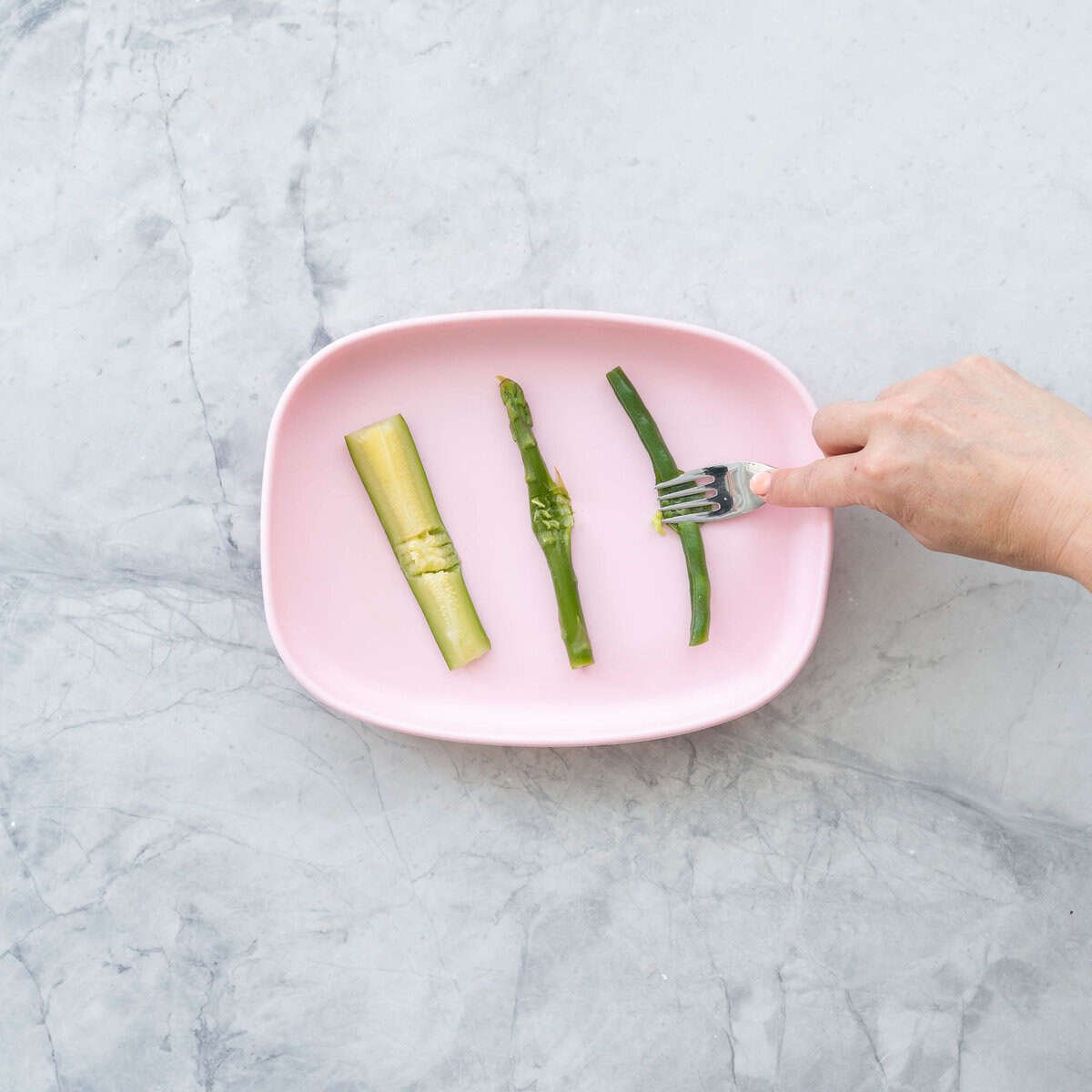
References & Further Reading
This guide draws on a variety of trusted sources in infant nutrition and baby-led weaning, including:
United Kingdom
- NICE Guideline NG247: Maternal and Child Nutrition (2024)
- NICE Quality Standard QS37: Postnatal Care
- British Dietetic Association – Complementary Feeding
United States
- AAP Policy Statement (2022): Breastfeeding and the Use of Human Milk
- AAP Healthy Active Living – Infant Feeding Guidance
Global – WHO
- WHO Guideline: Complementary Feeding of Infants and Young Children (2023)
- WHO Fact Sheet: Infant and Young Child Feeding

Quick Start Guide To BLW
Baby led weaning doesn’t need to be complicated, grab my quick start guide to begin your little ones food journey.